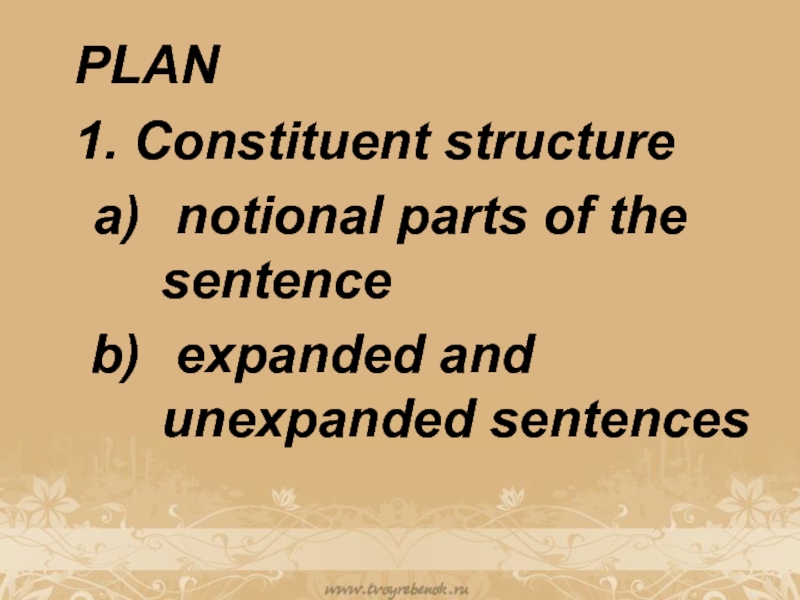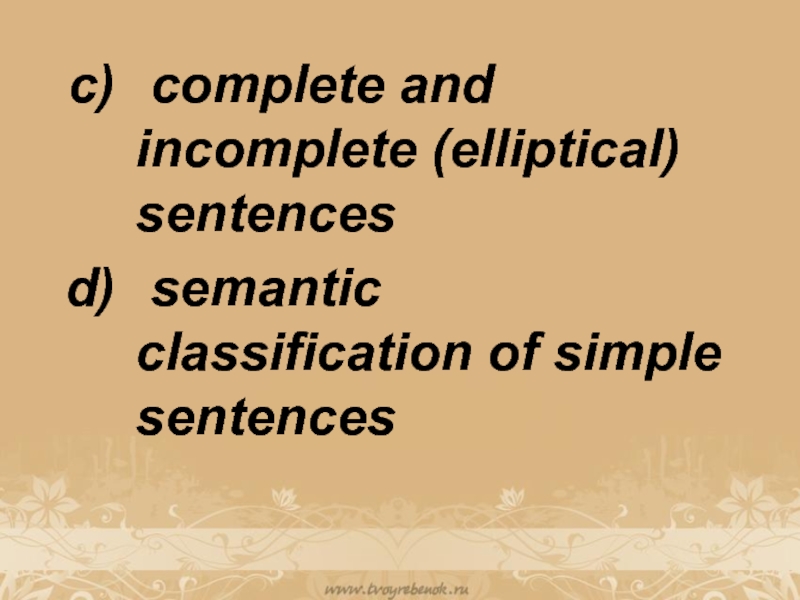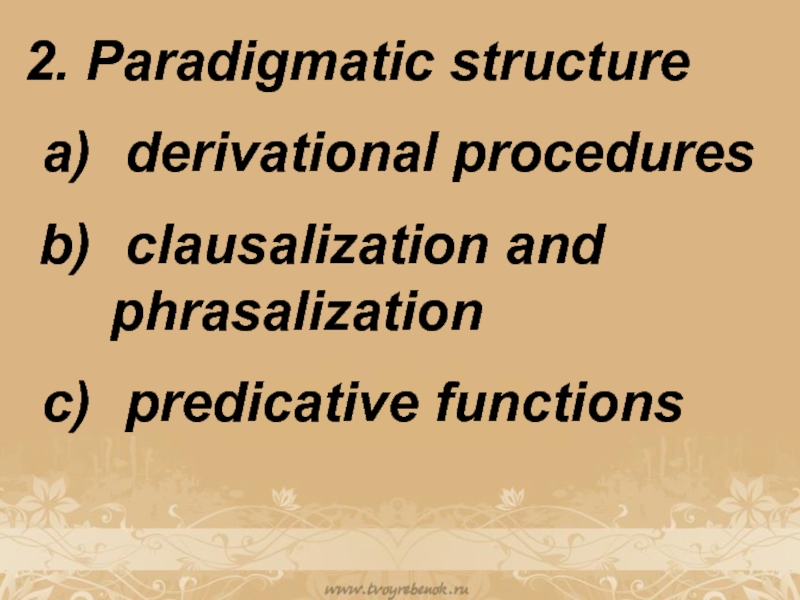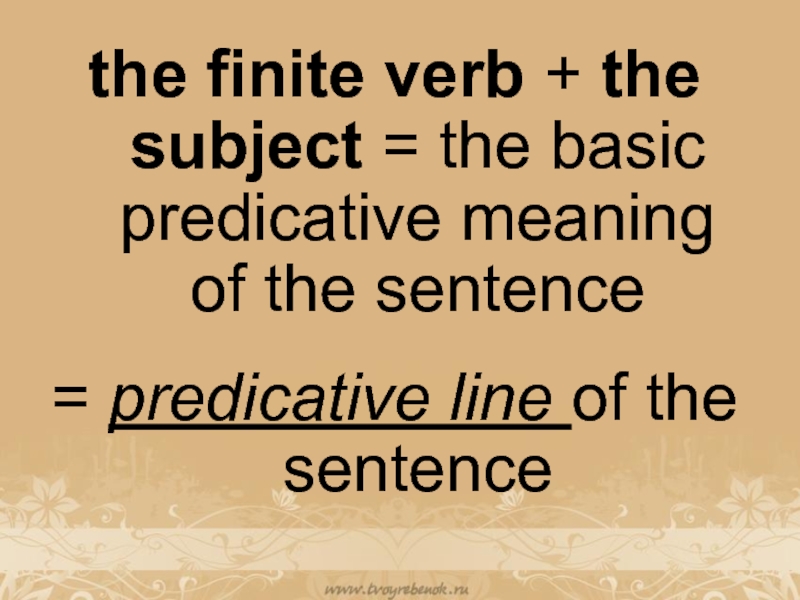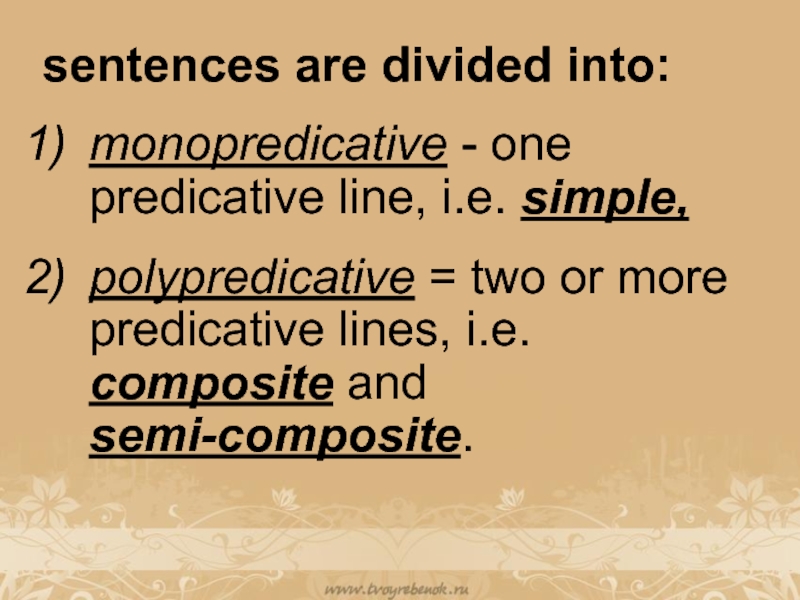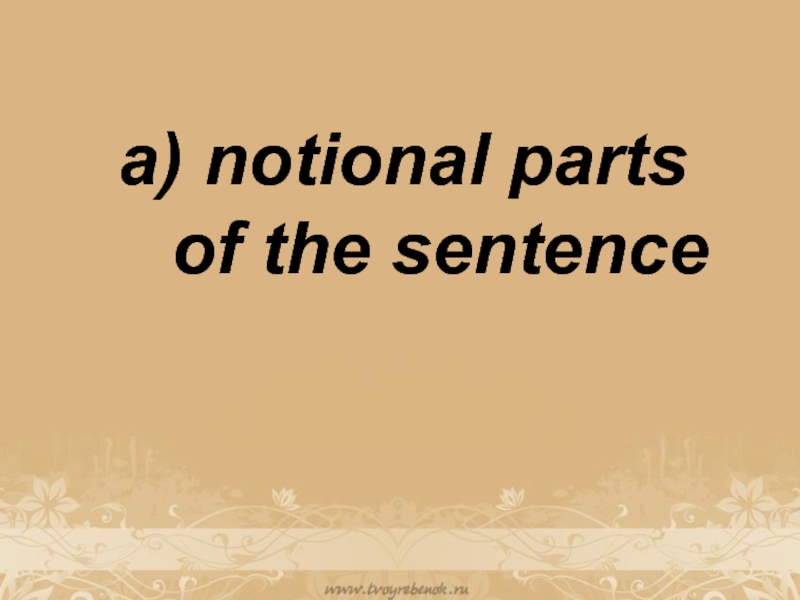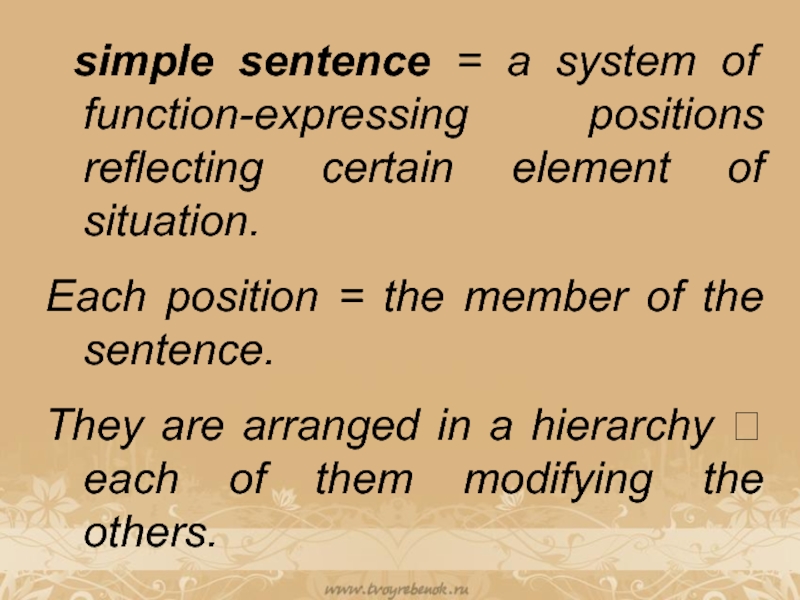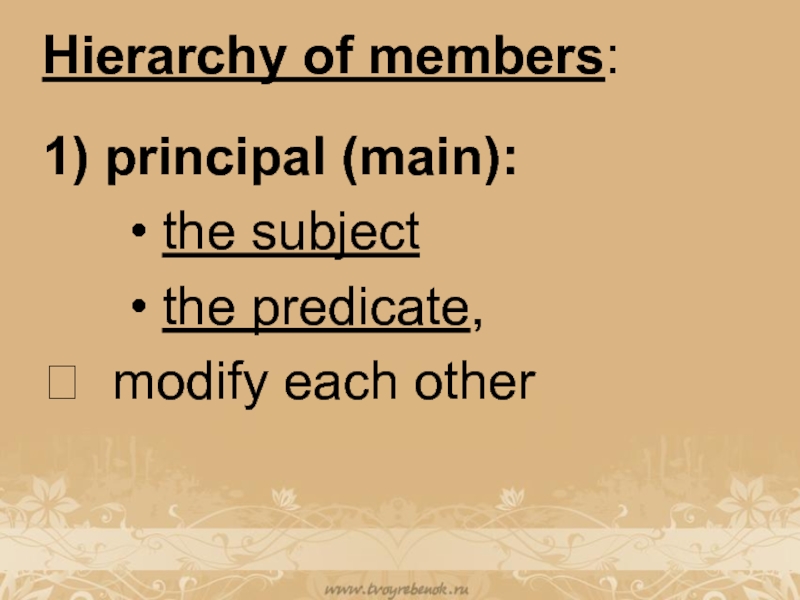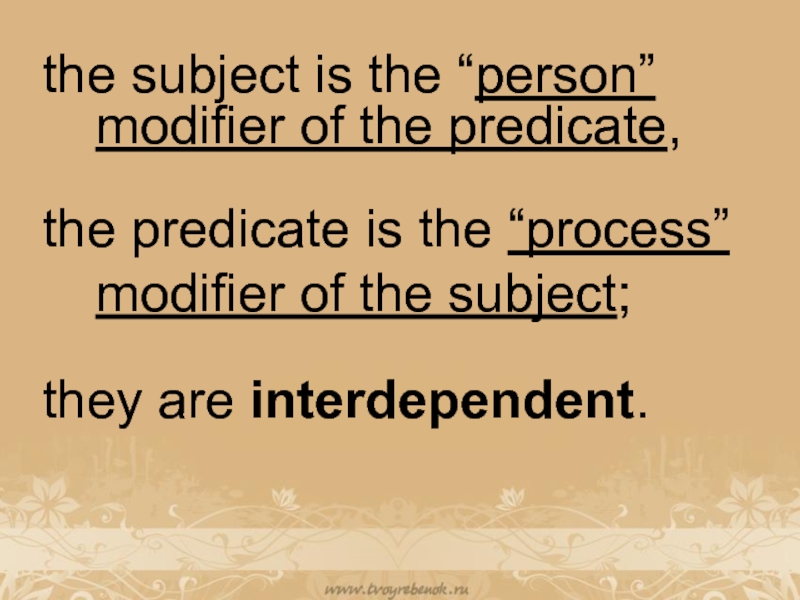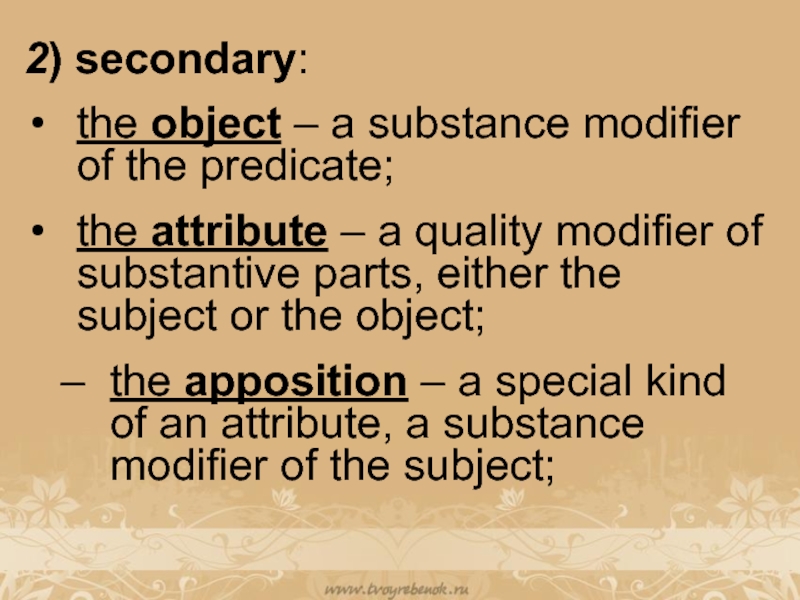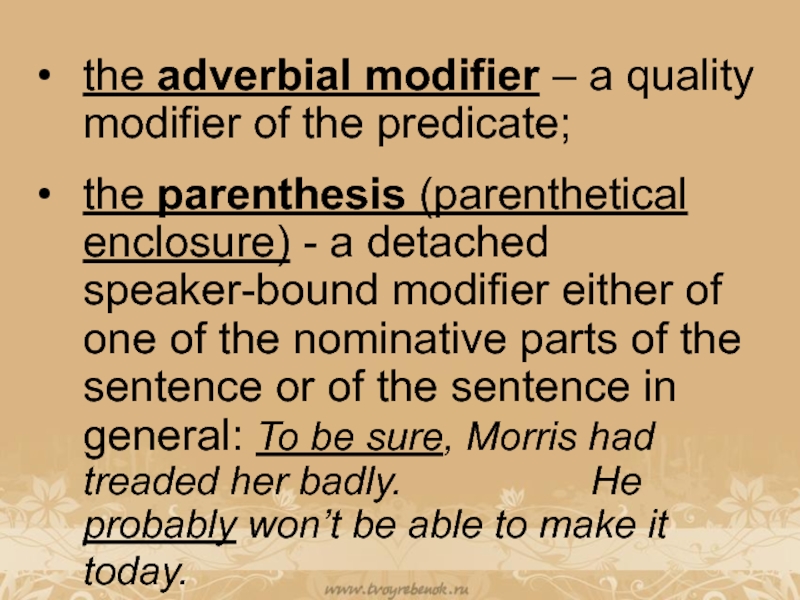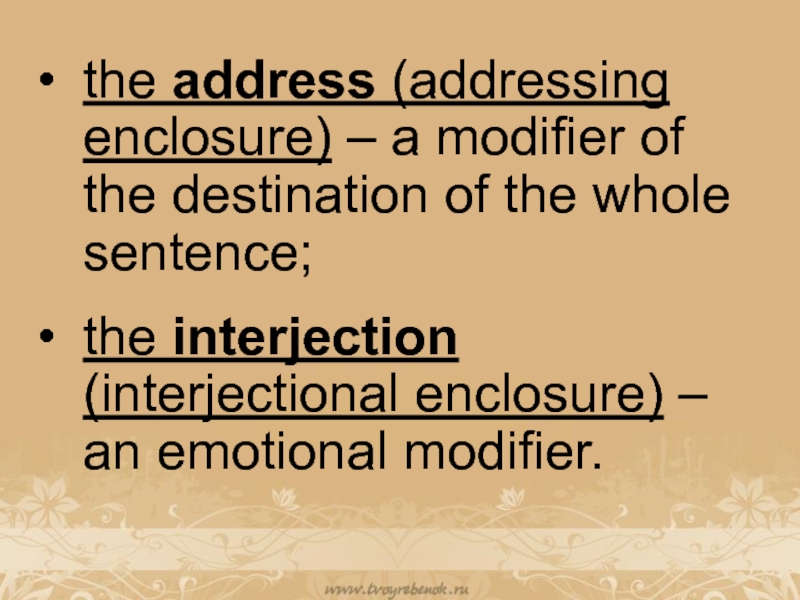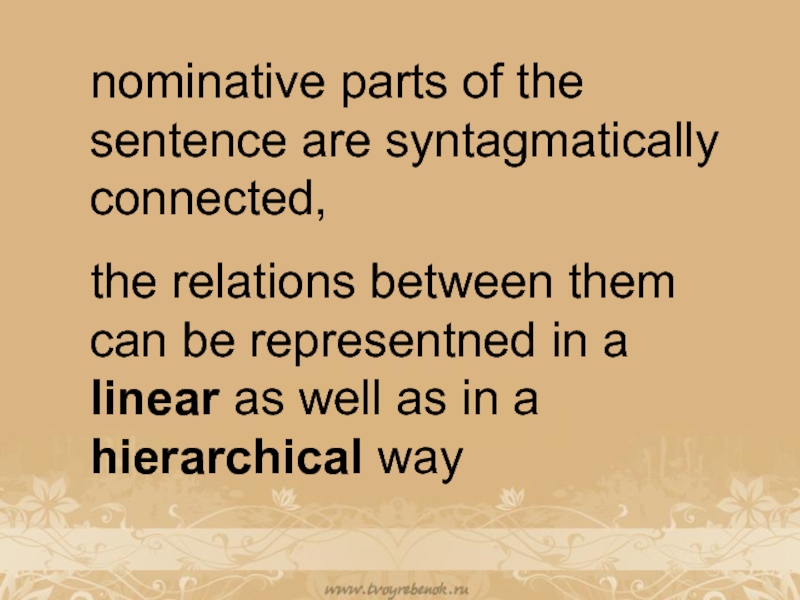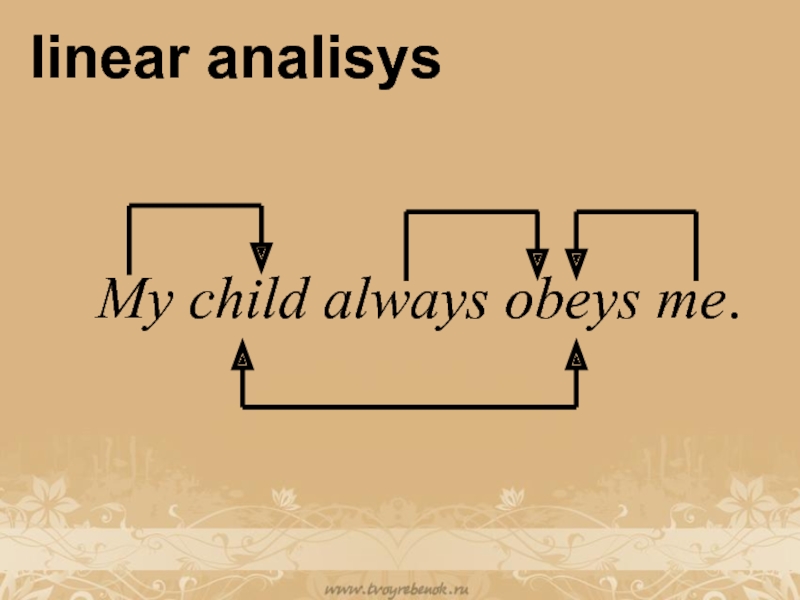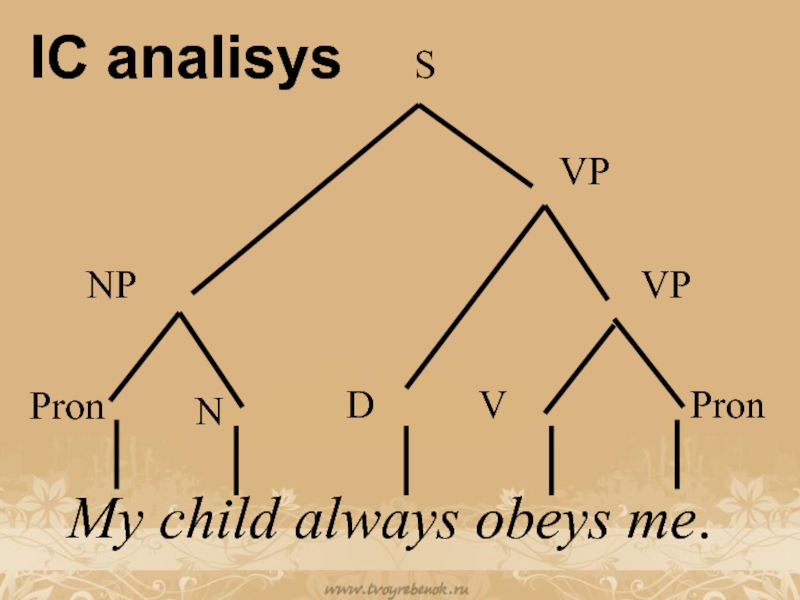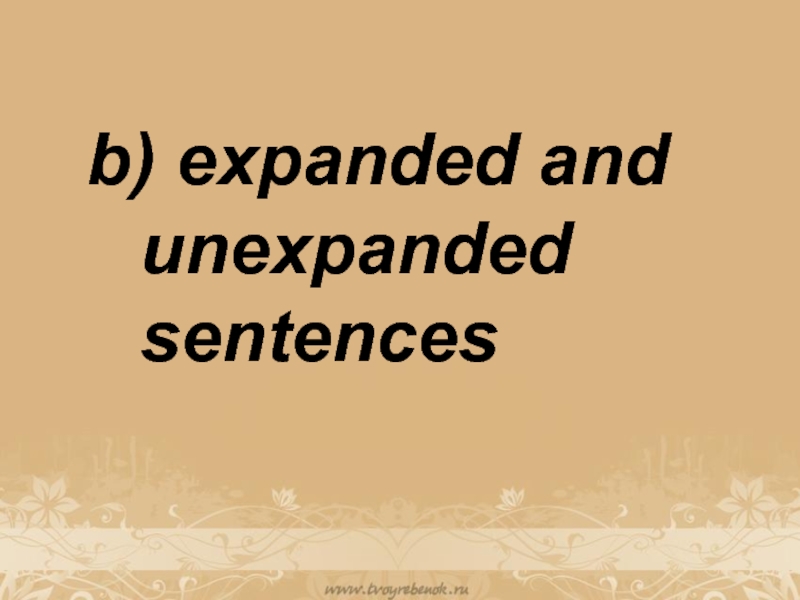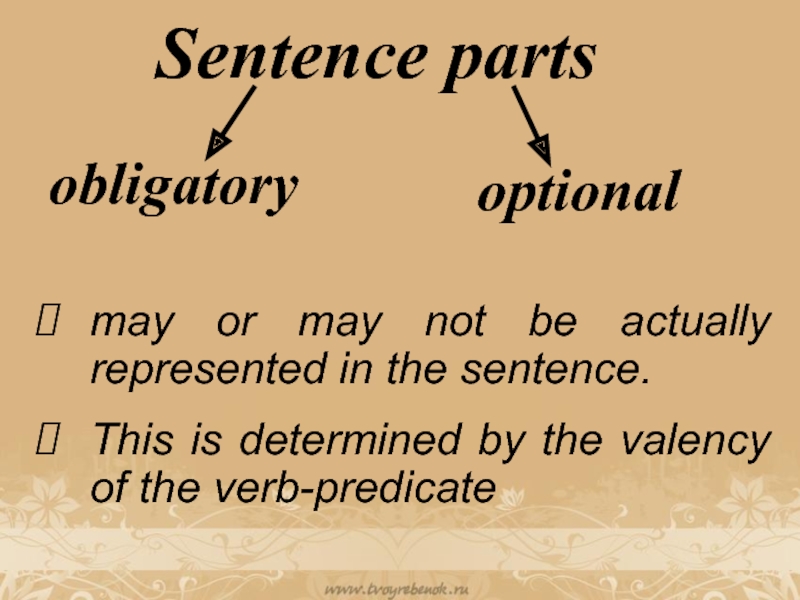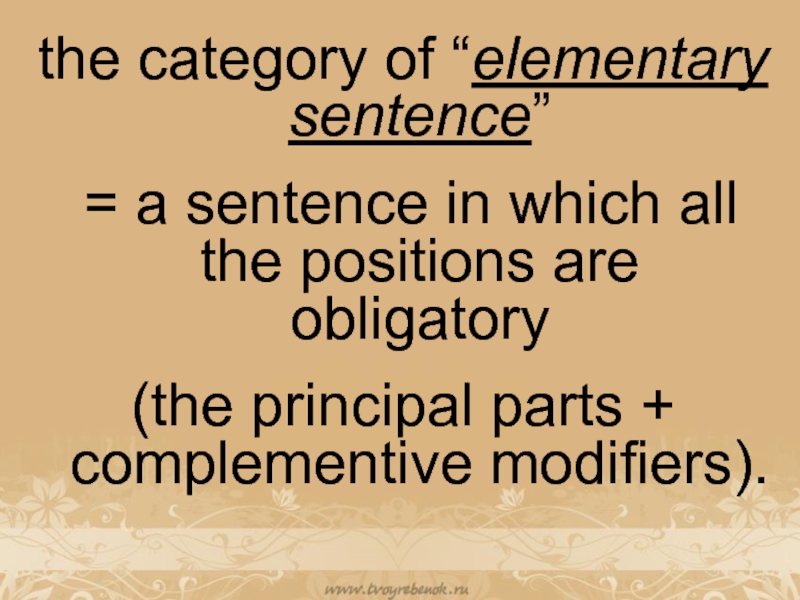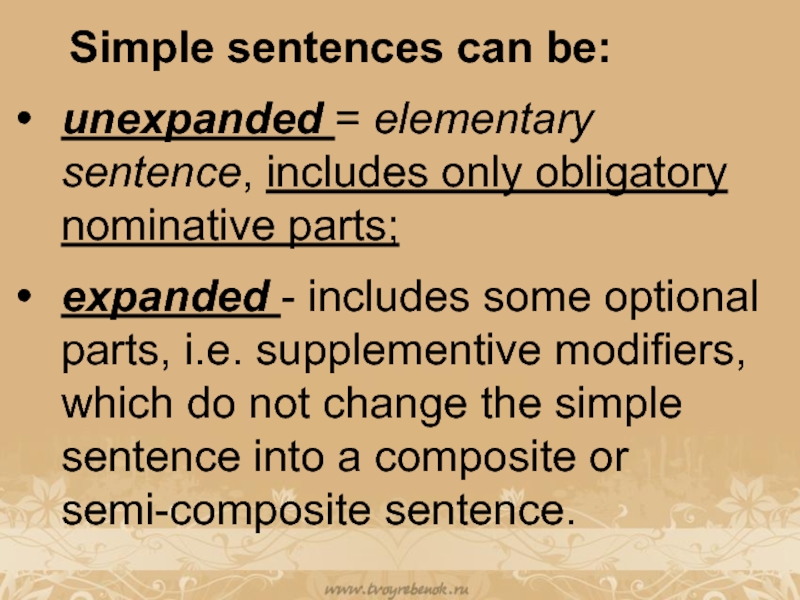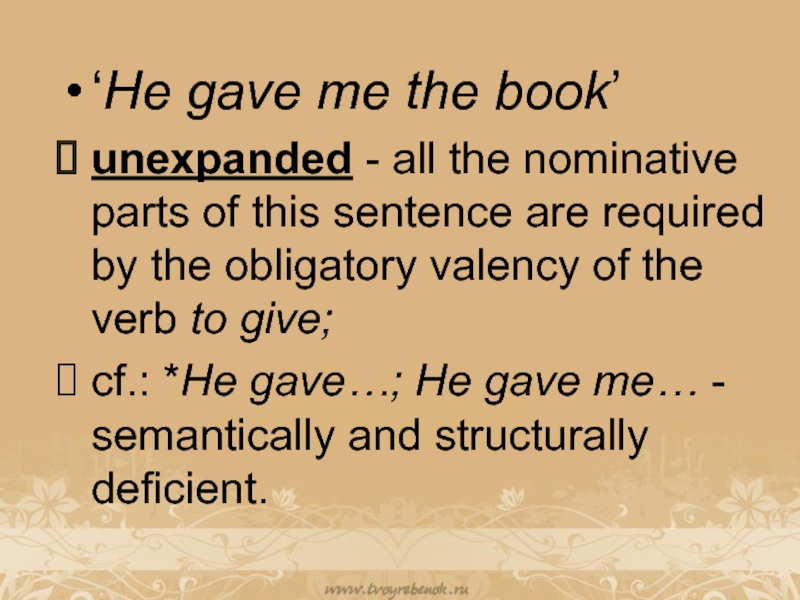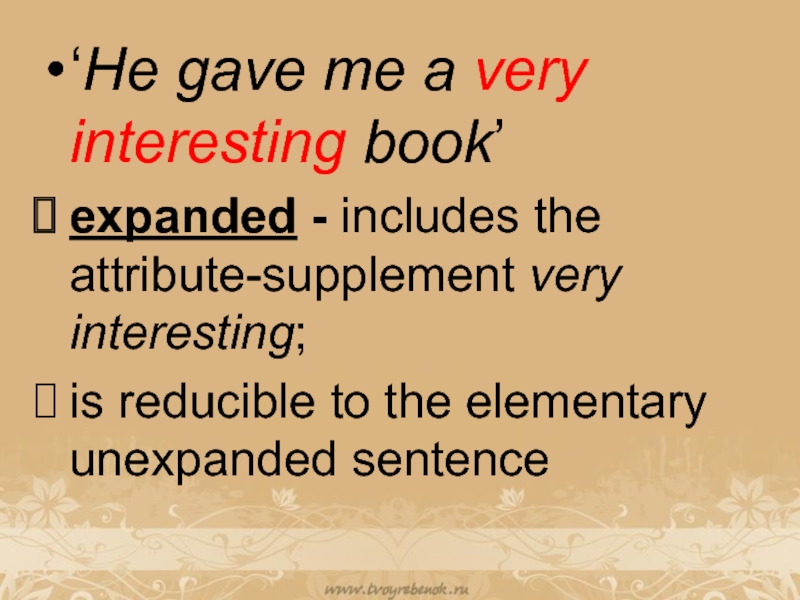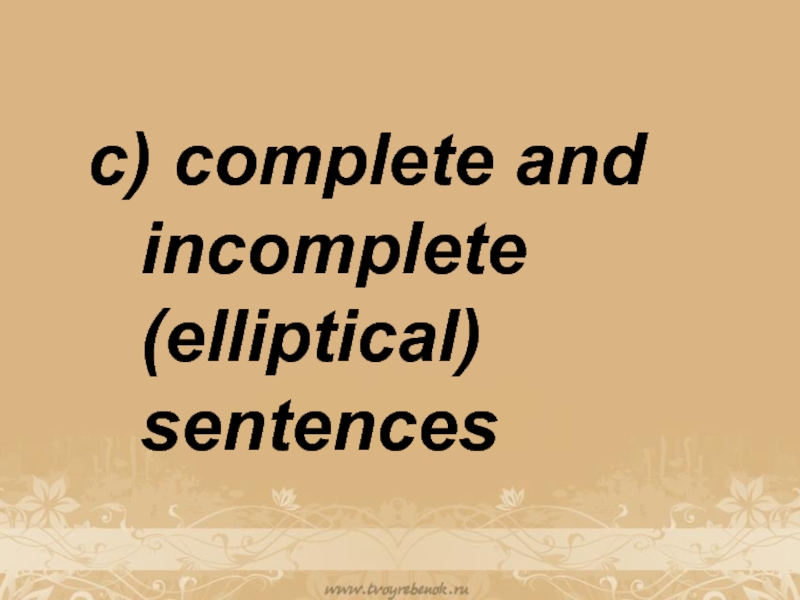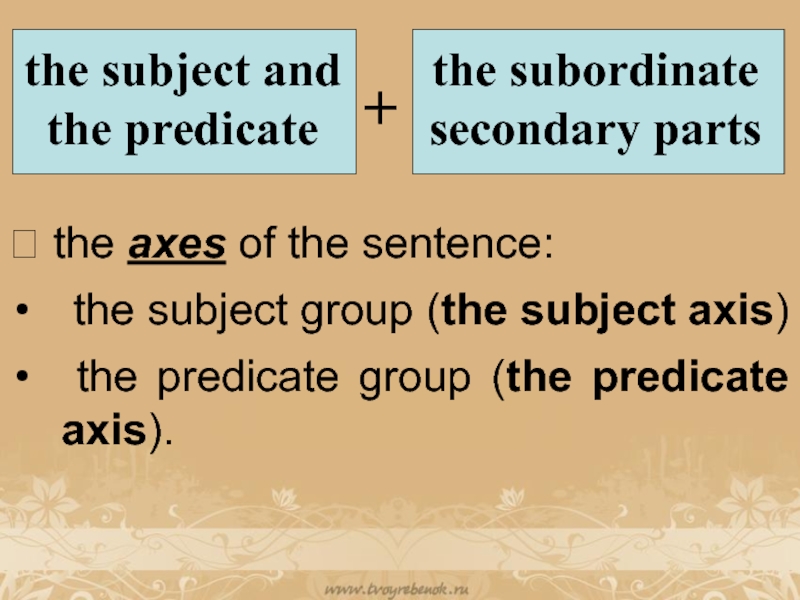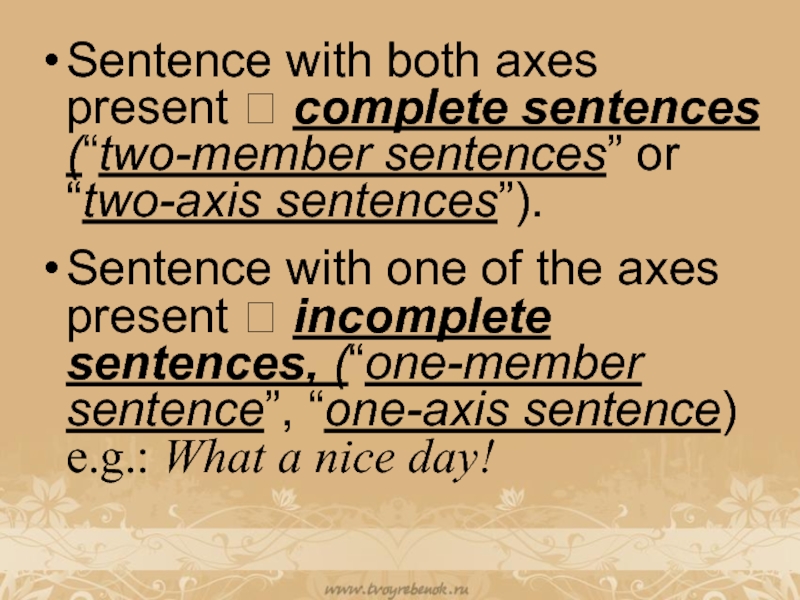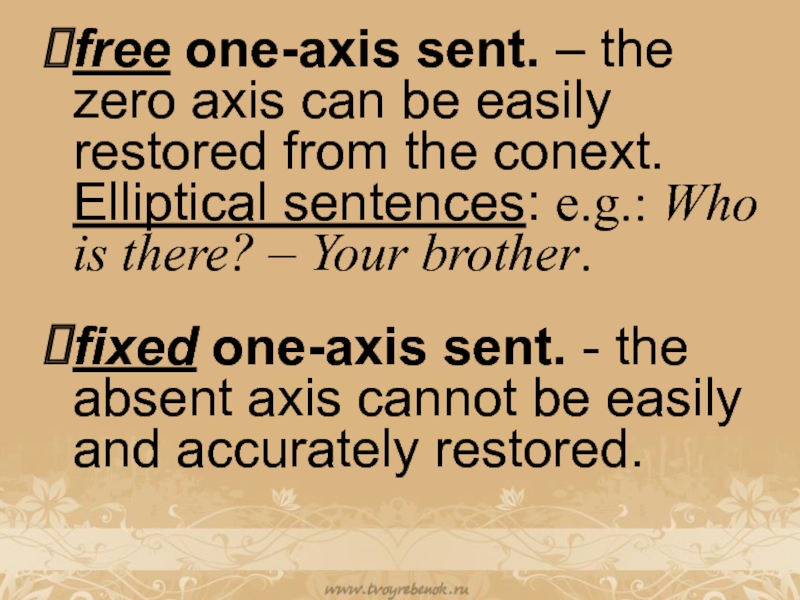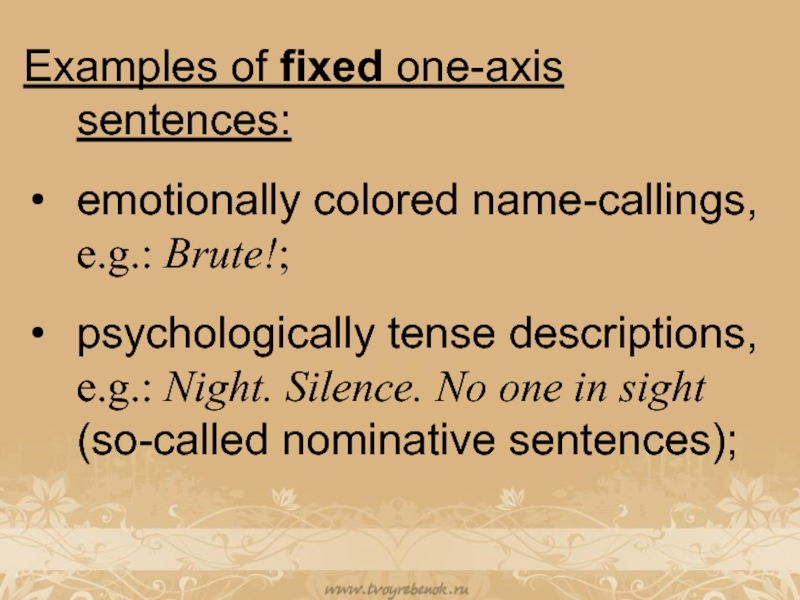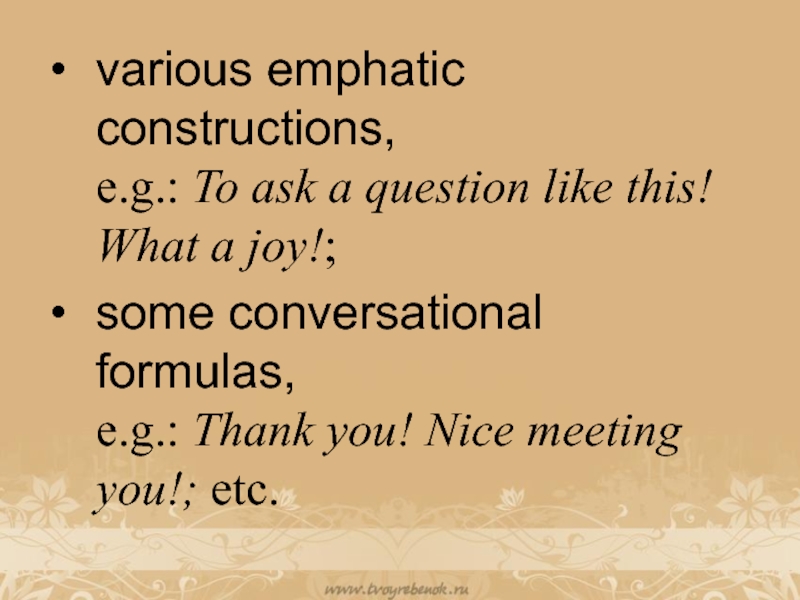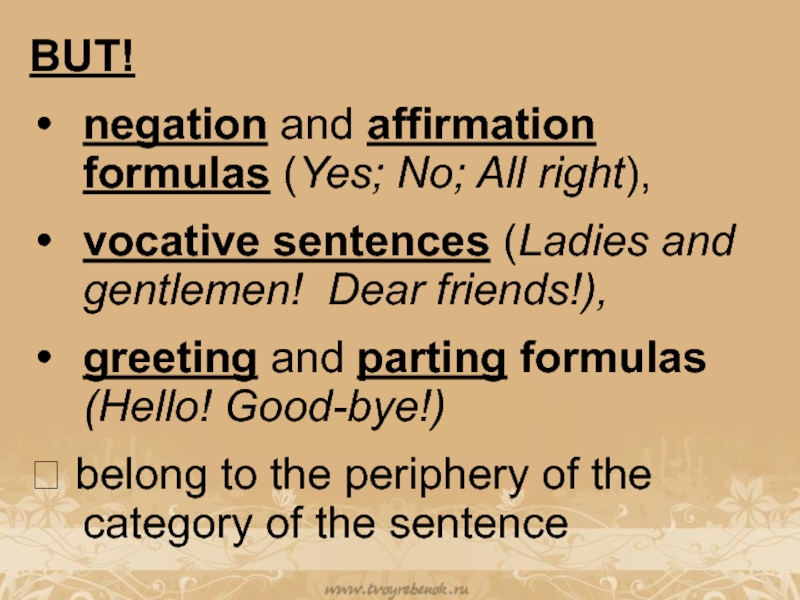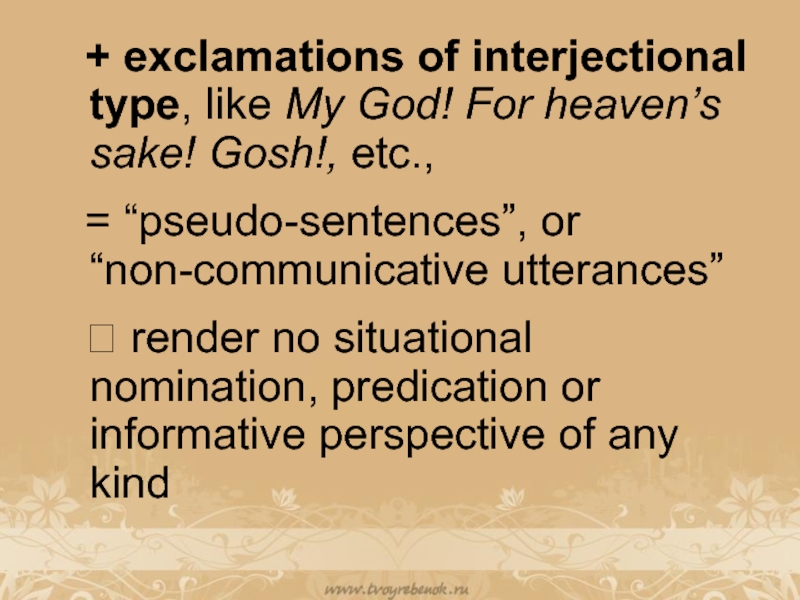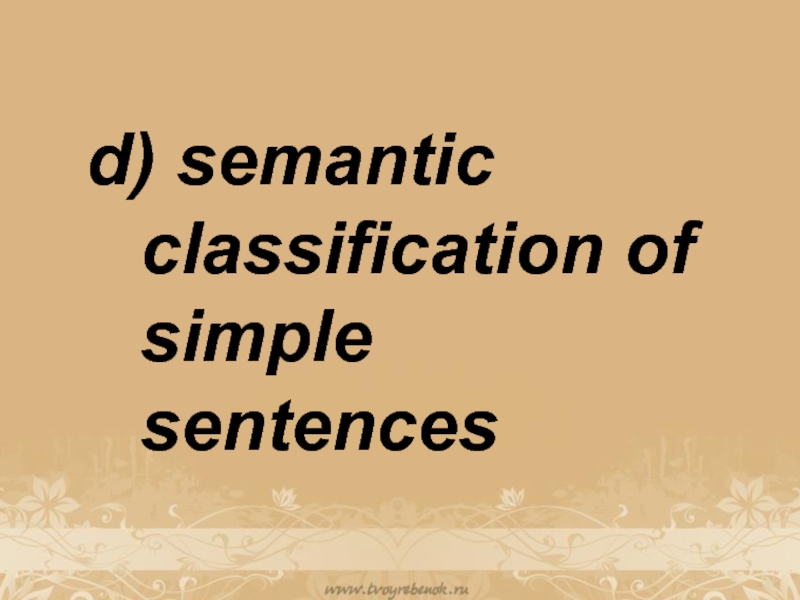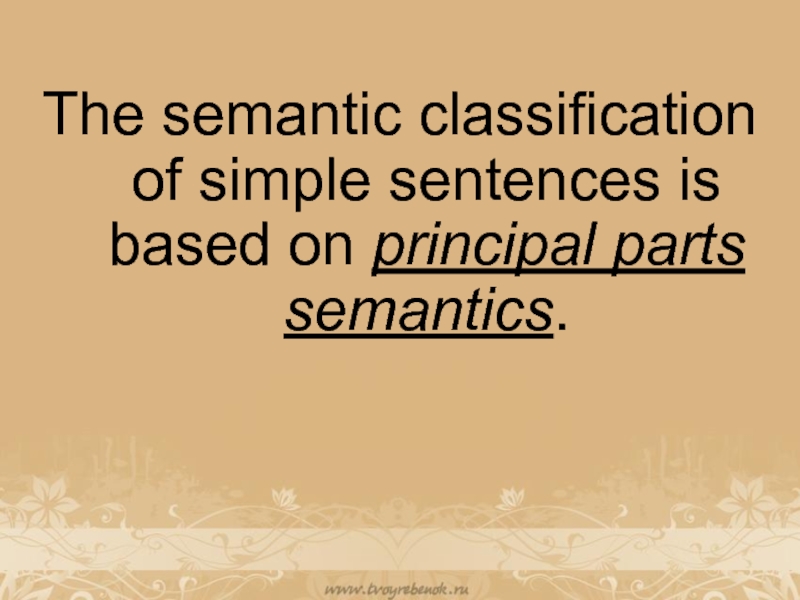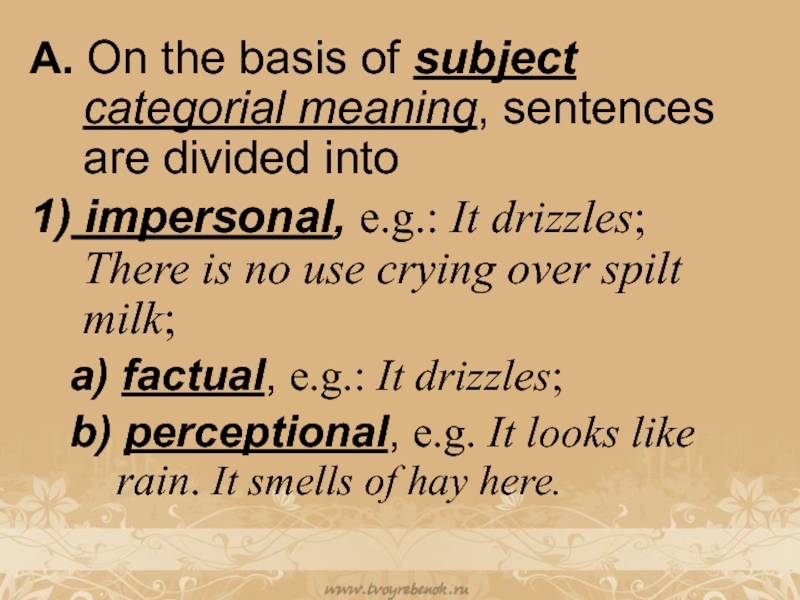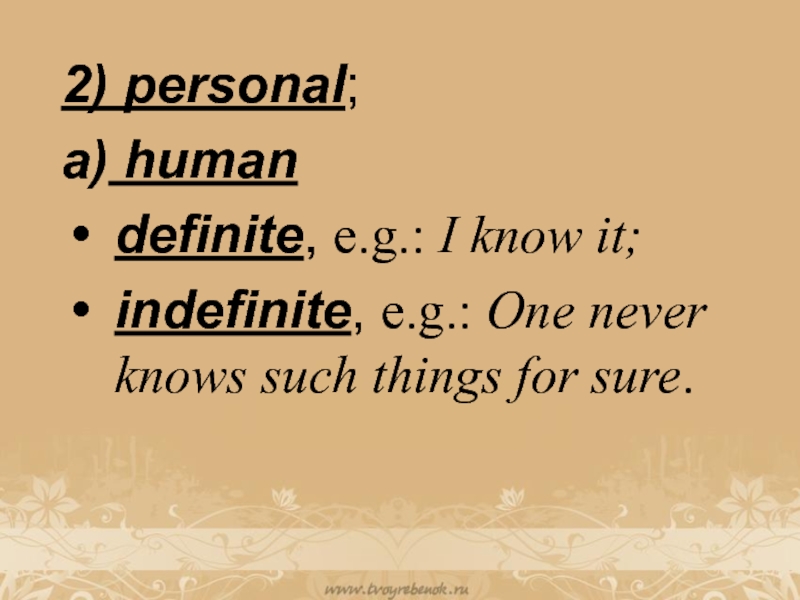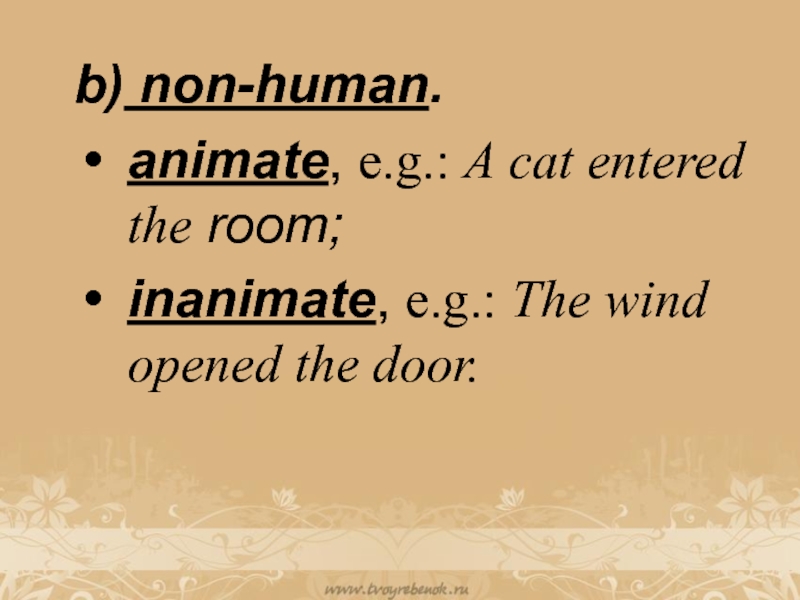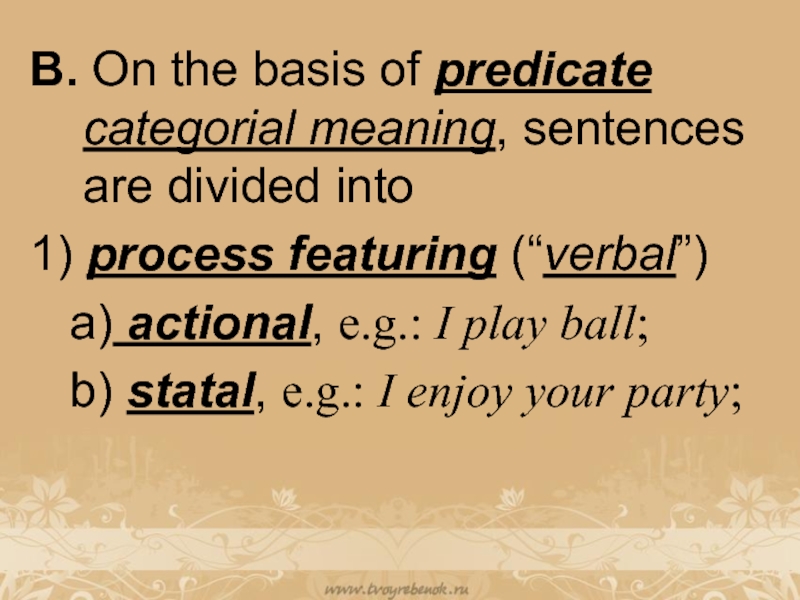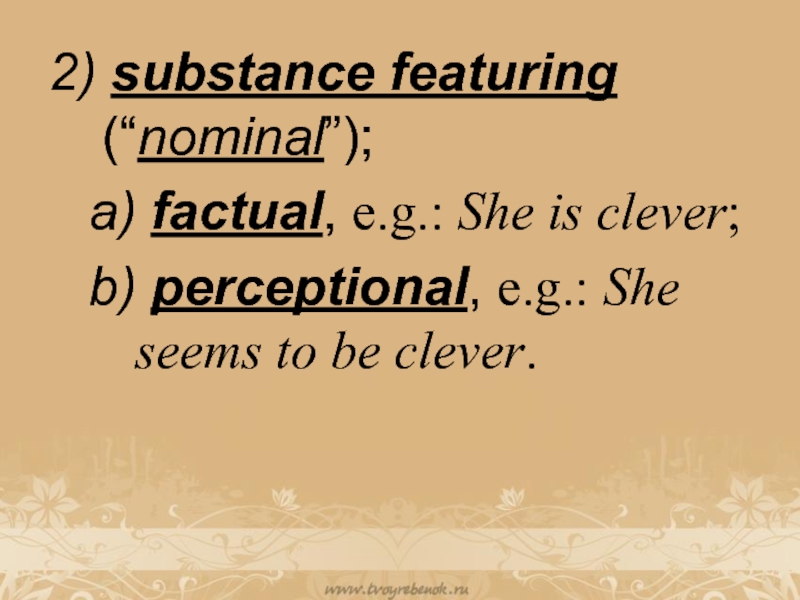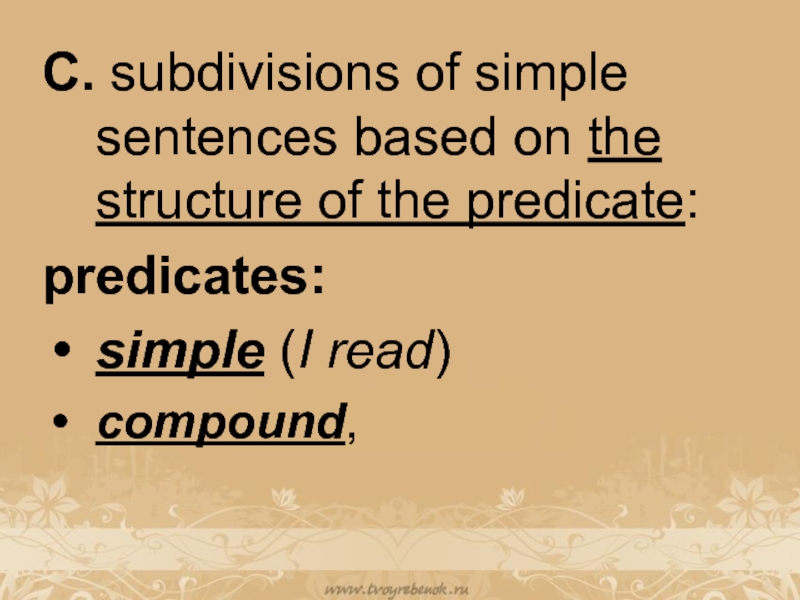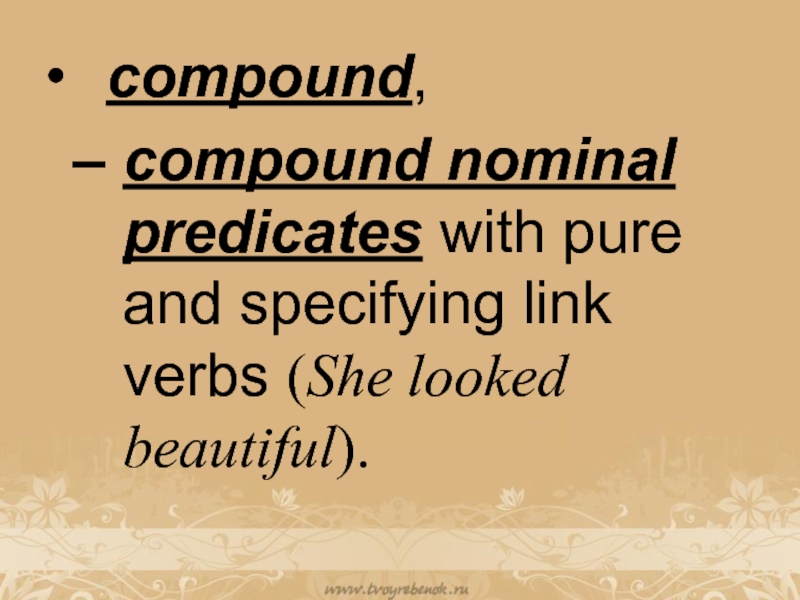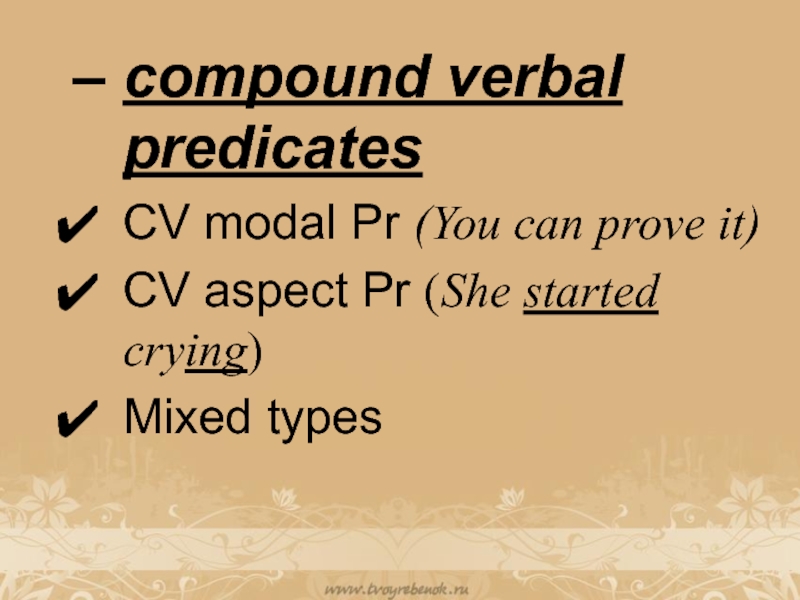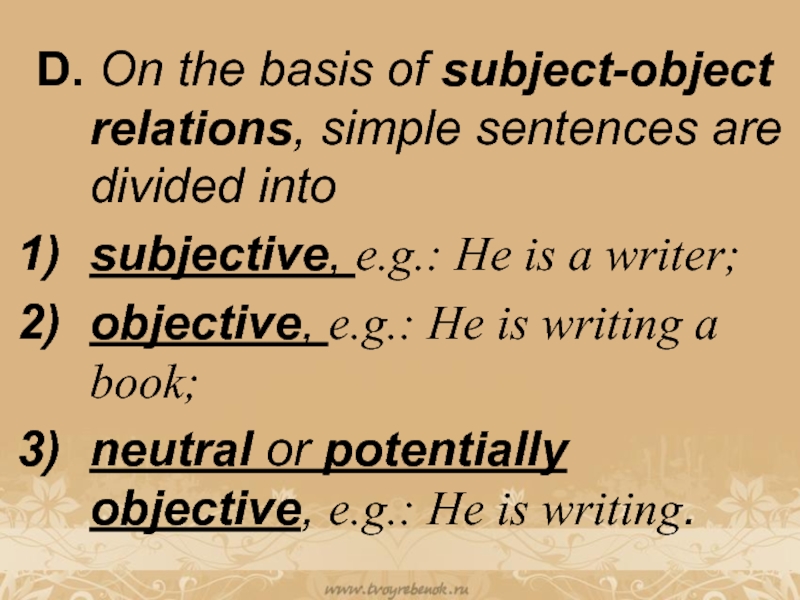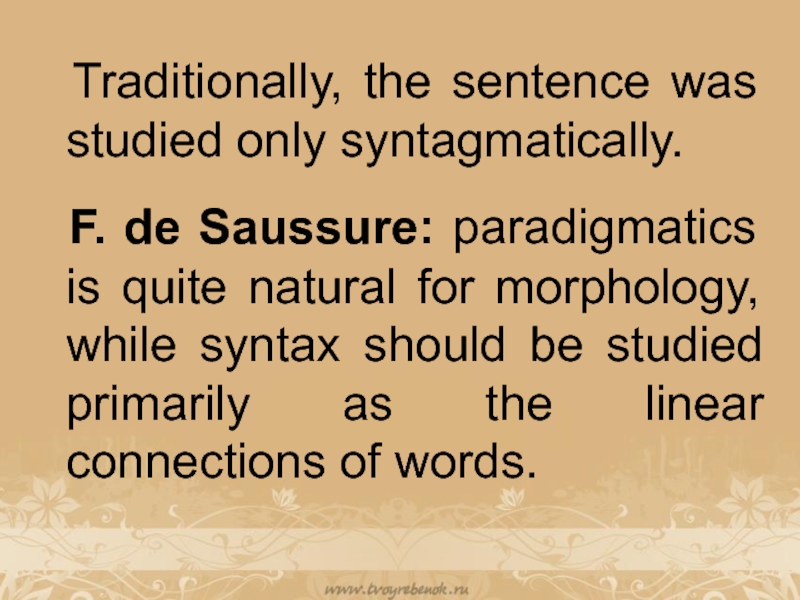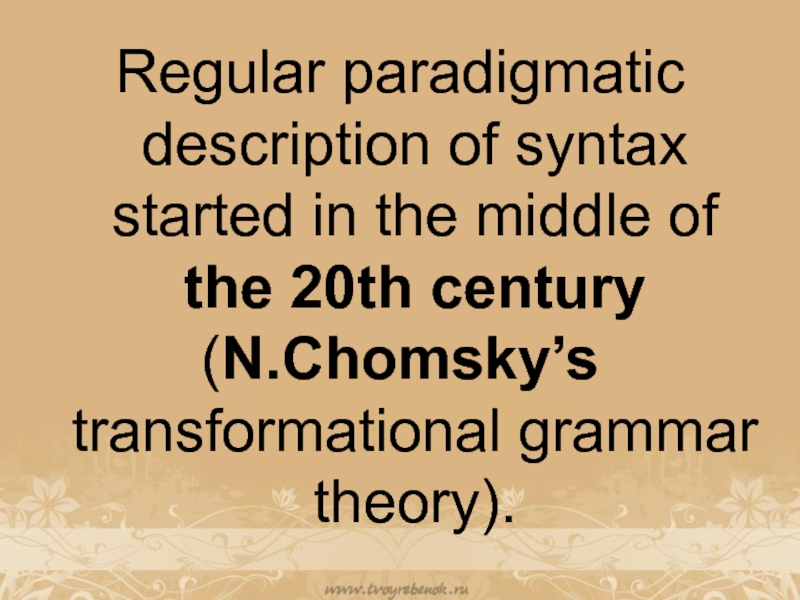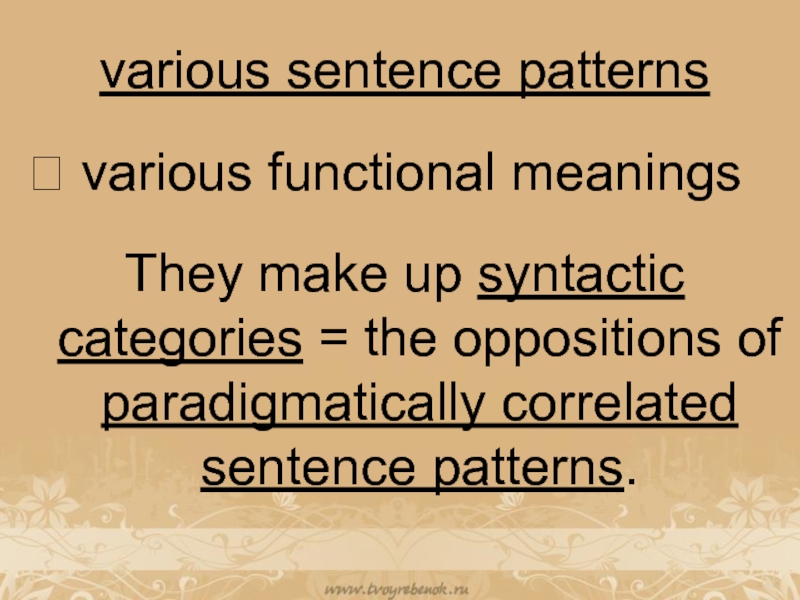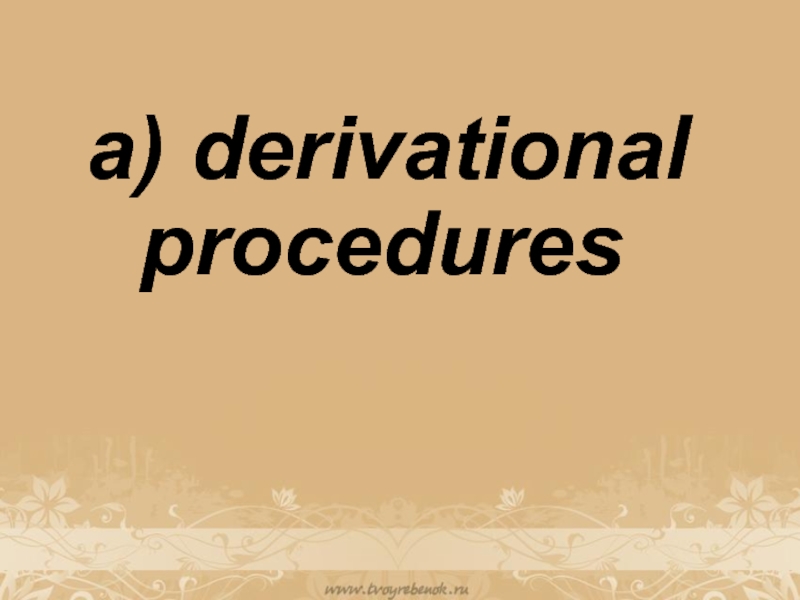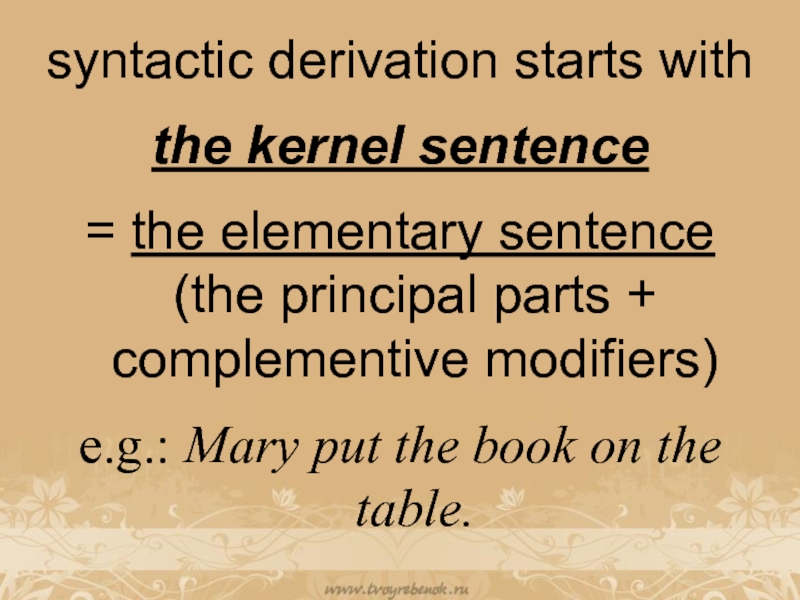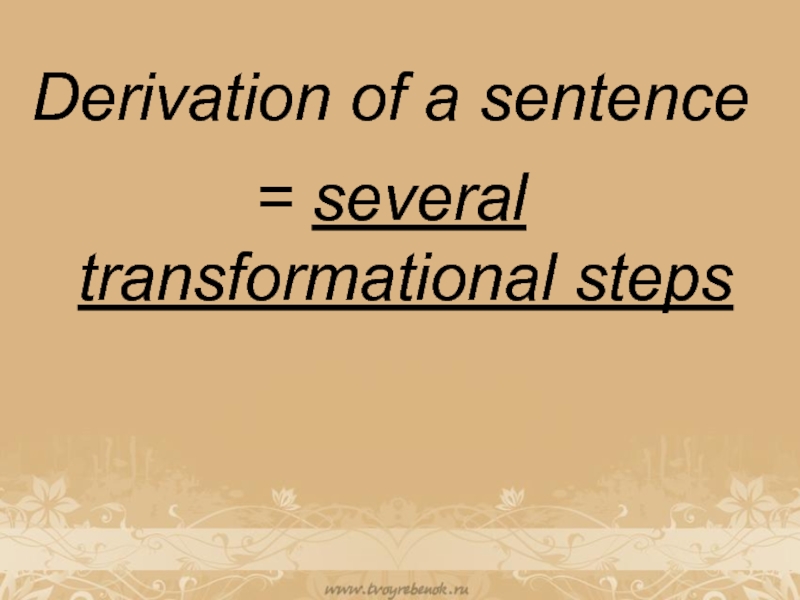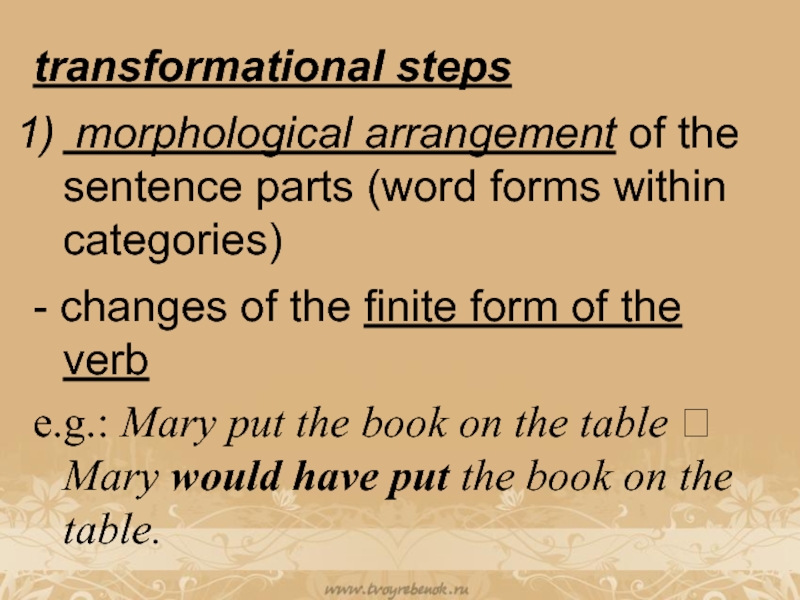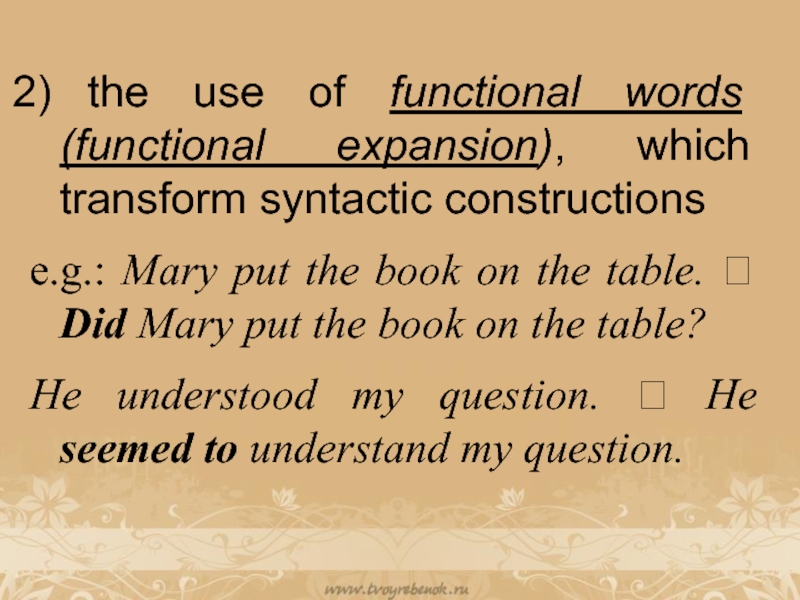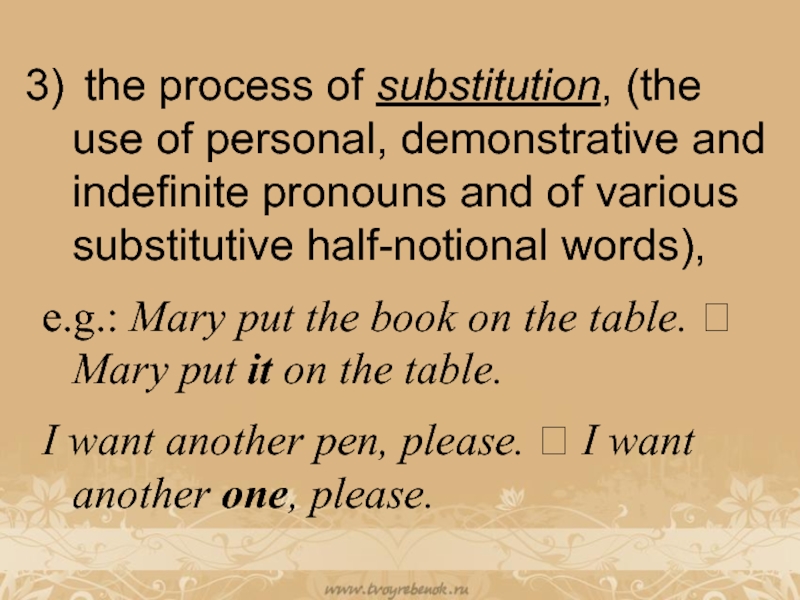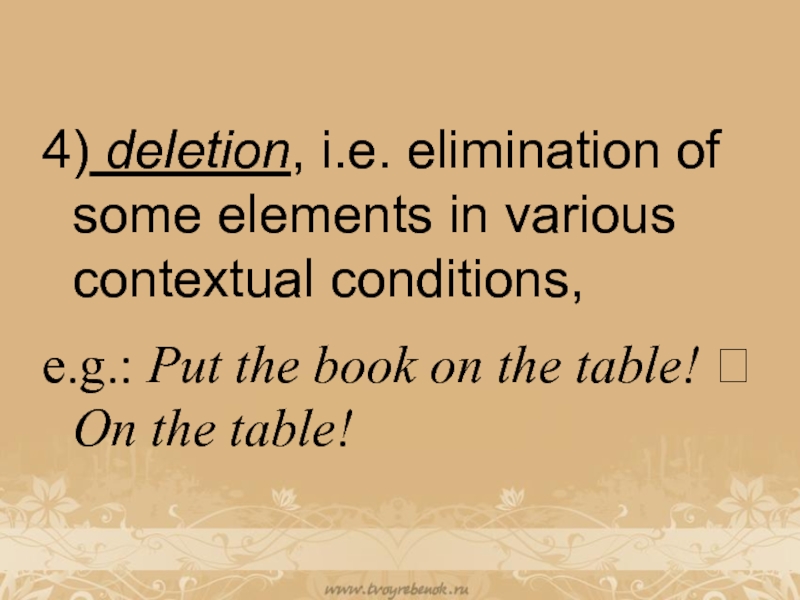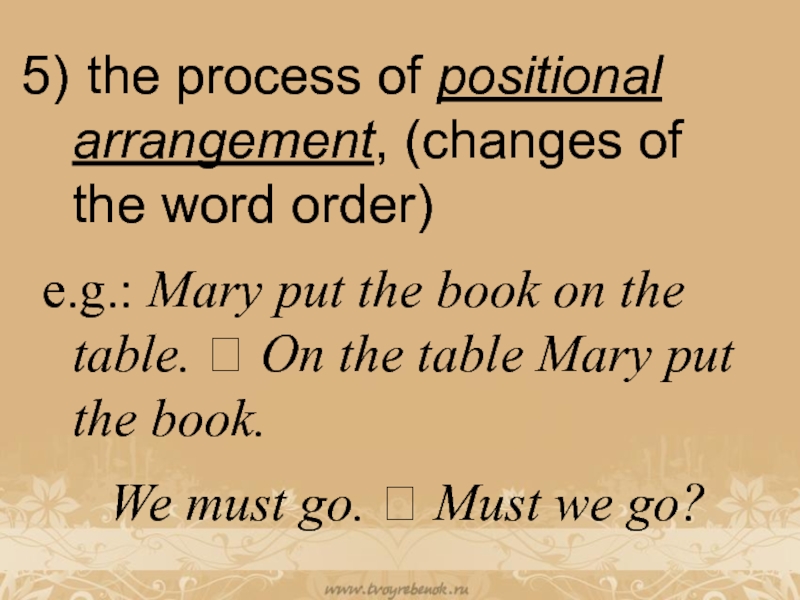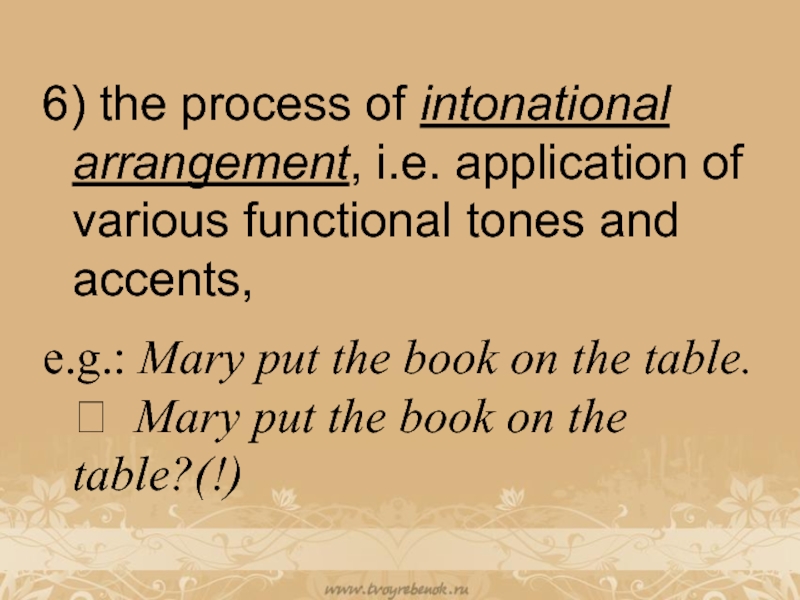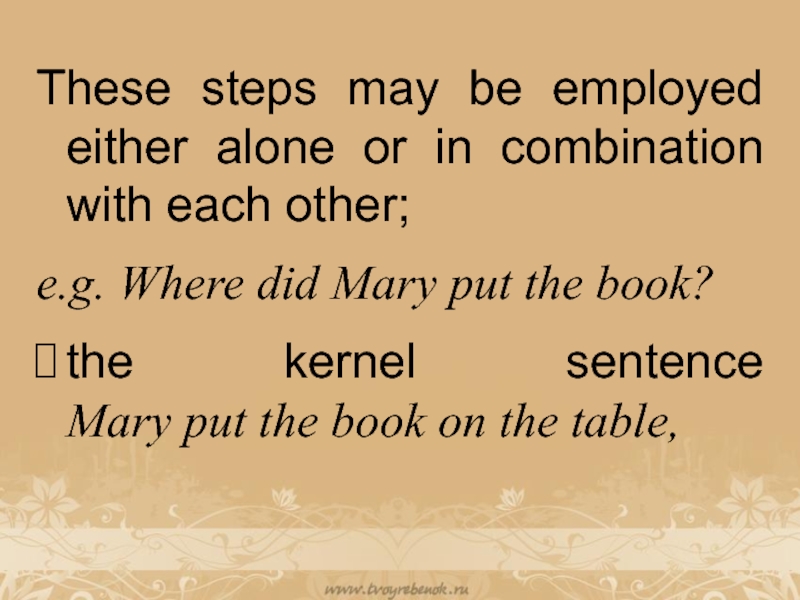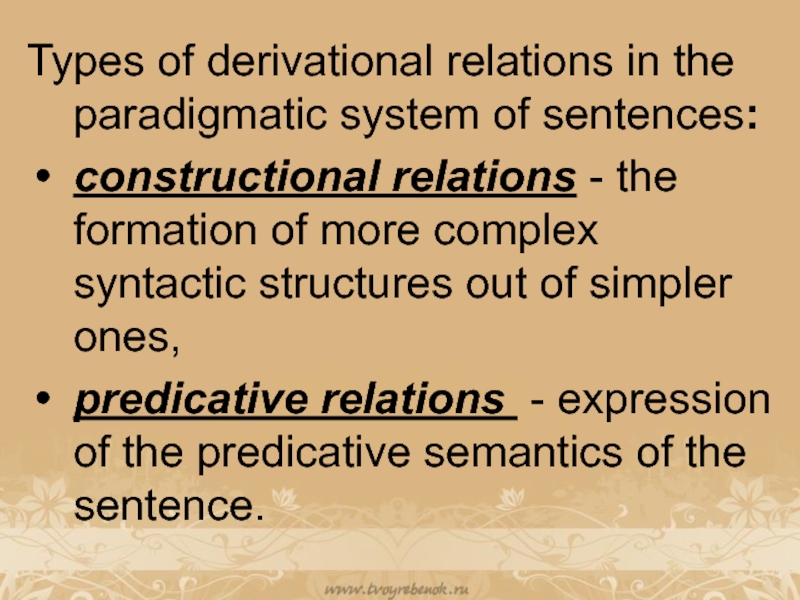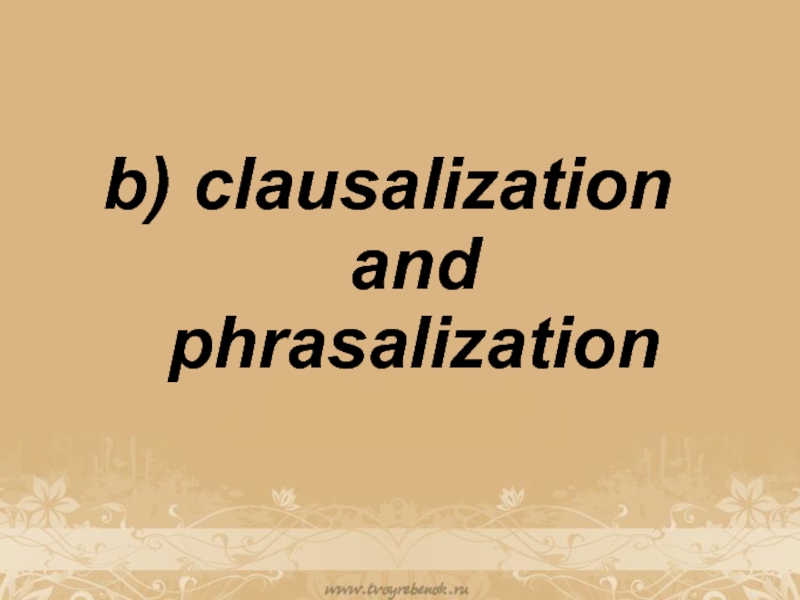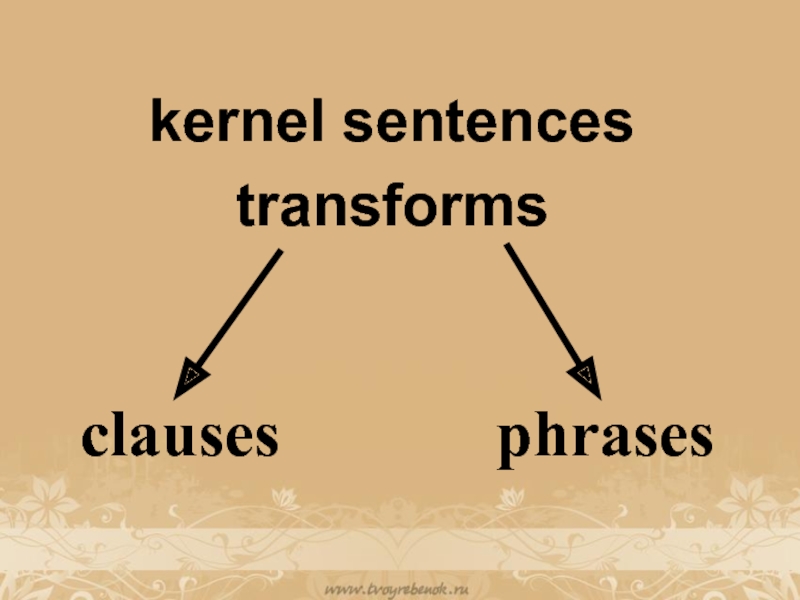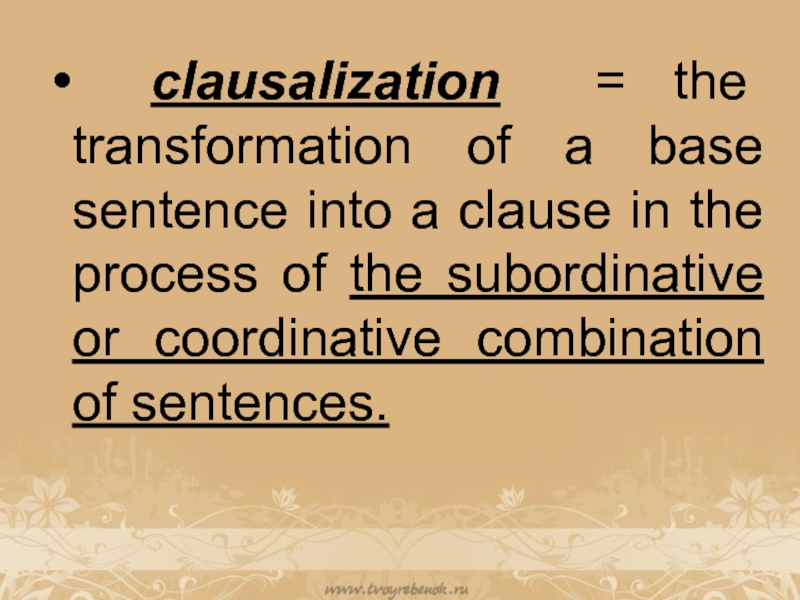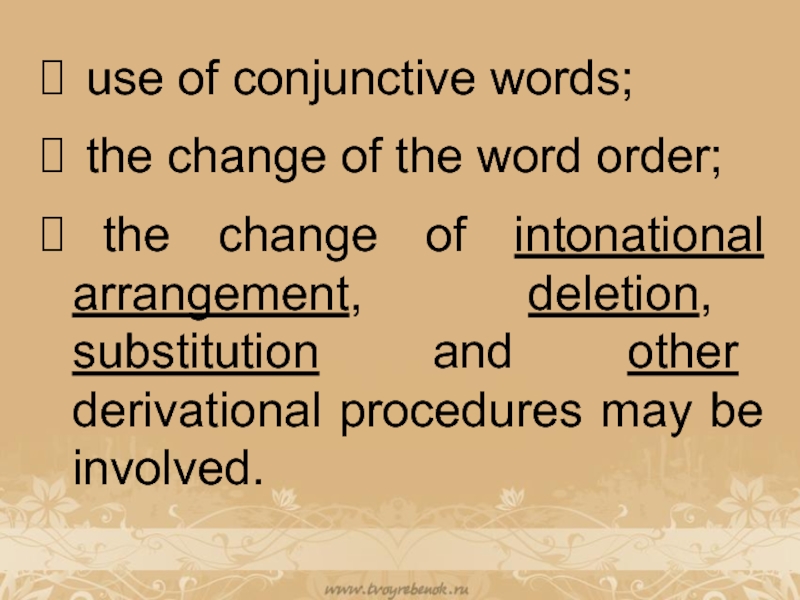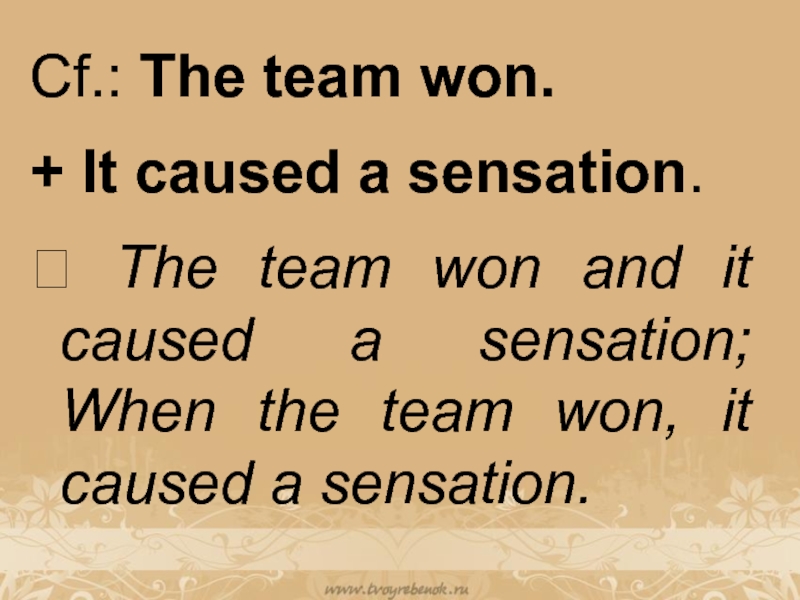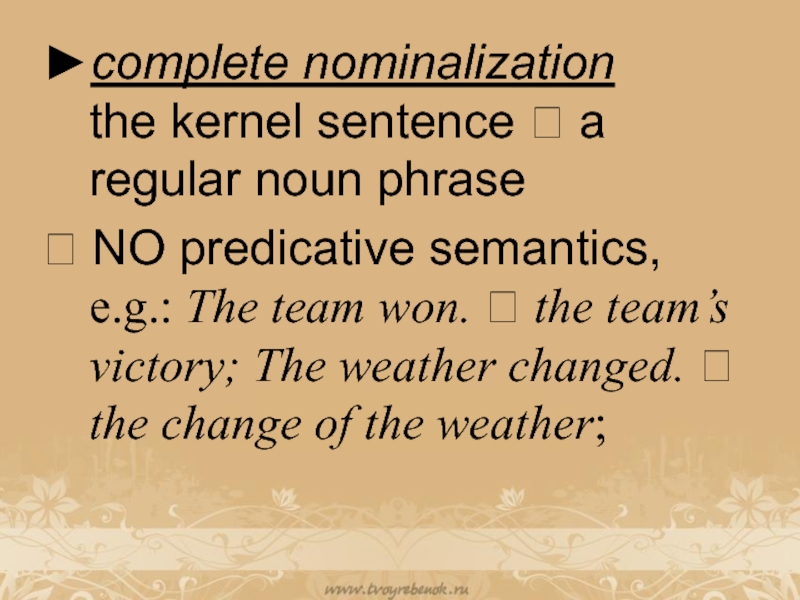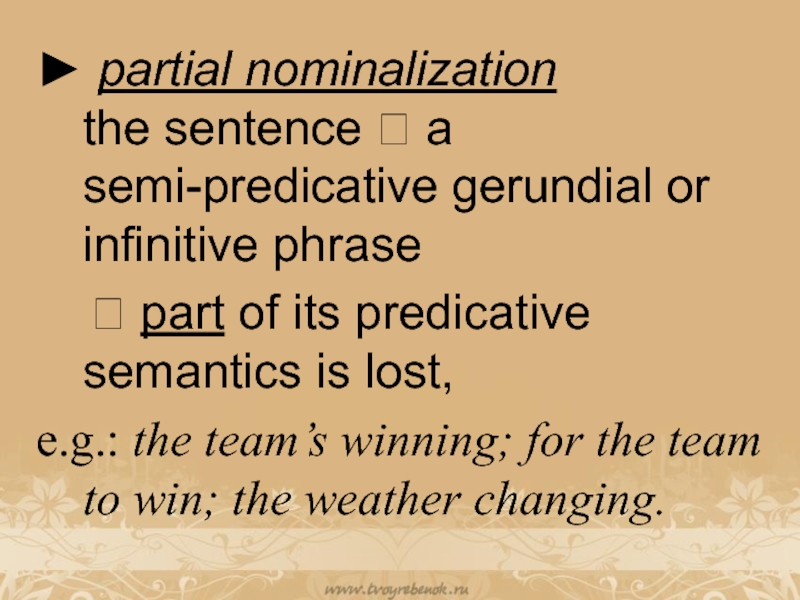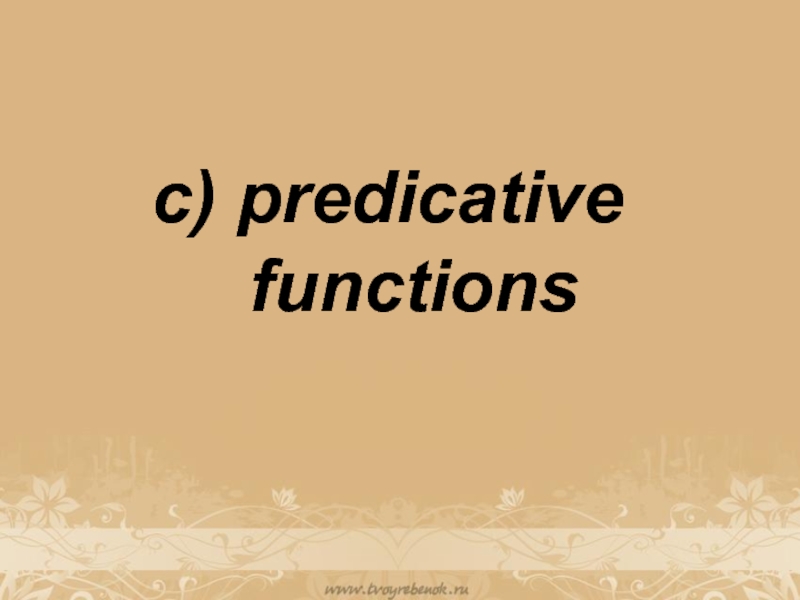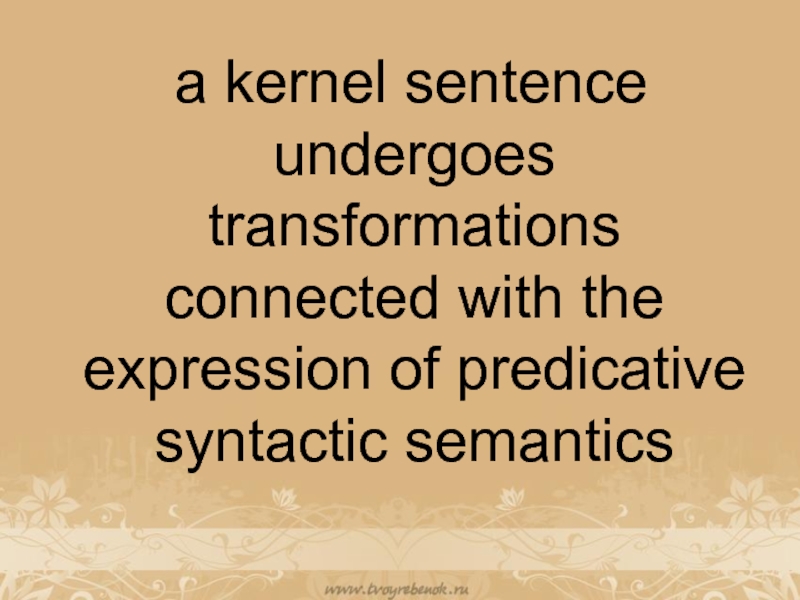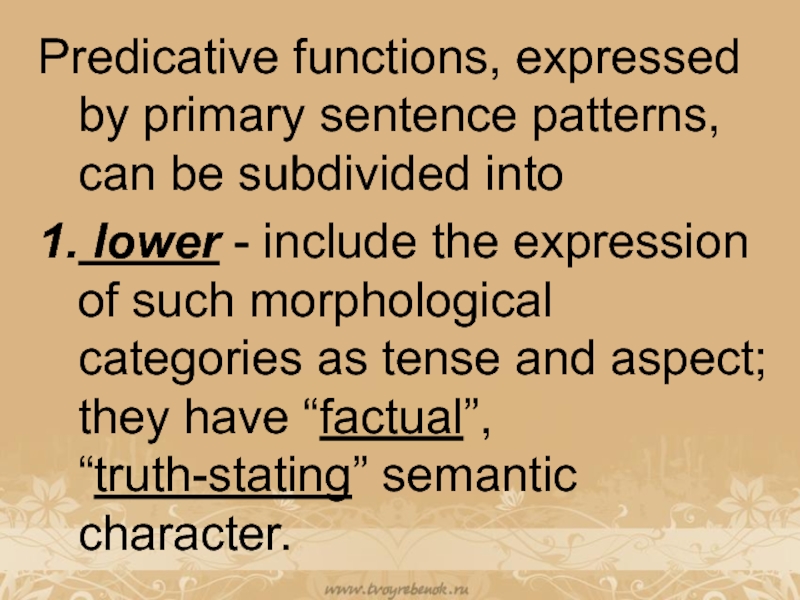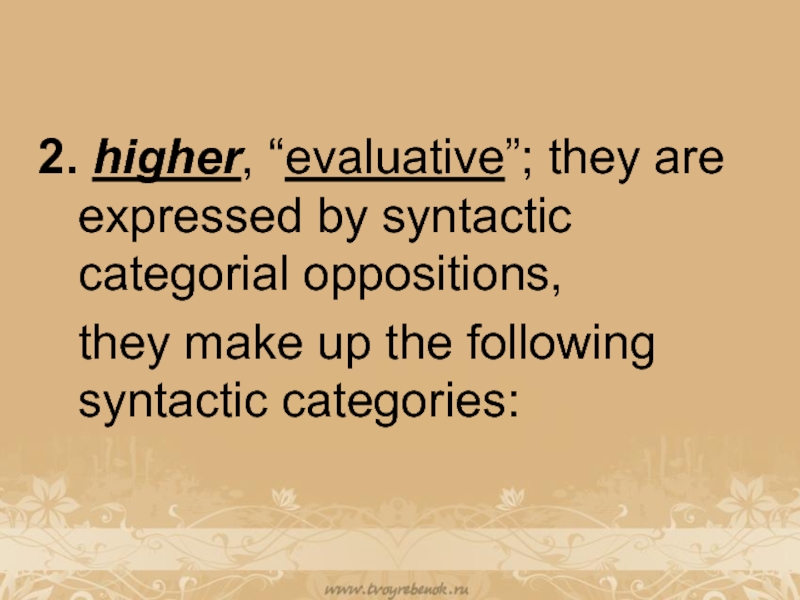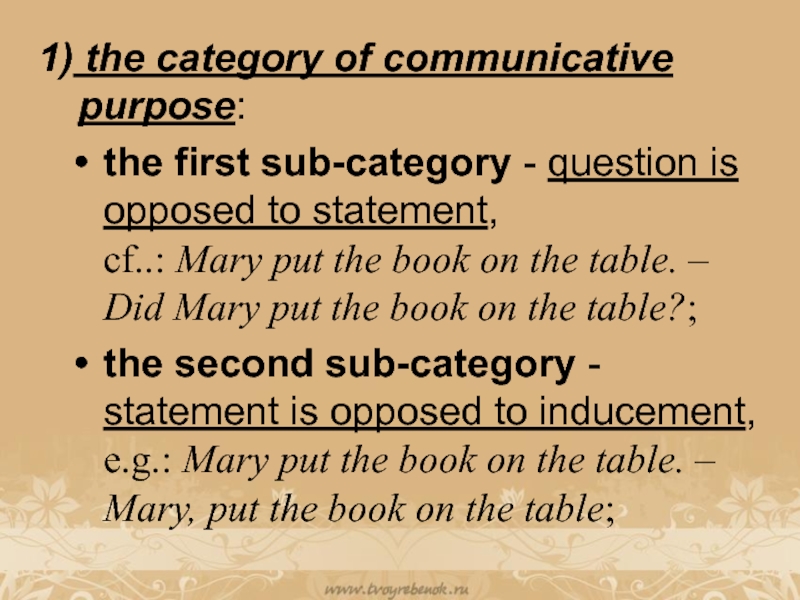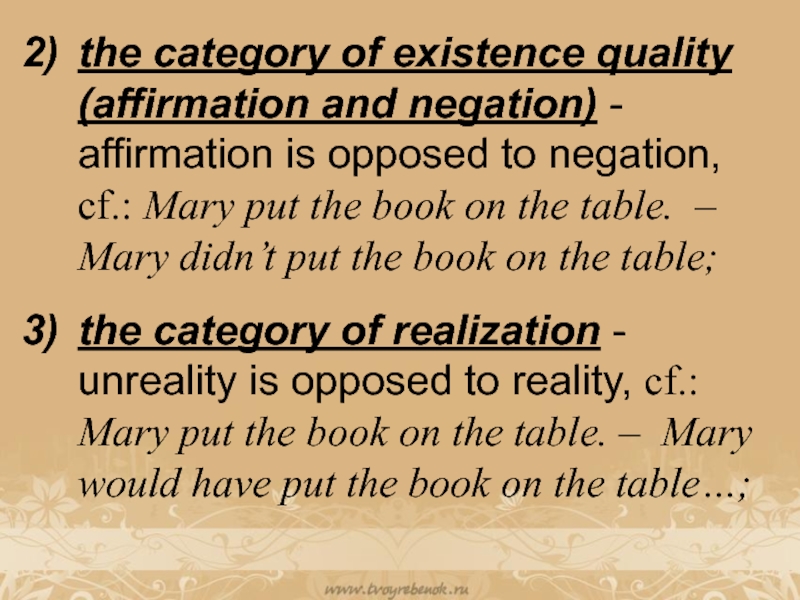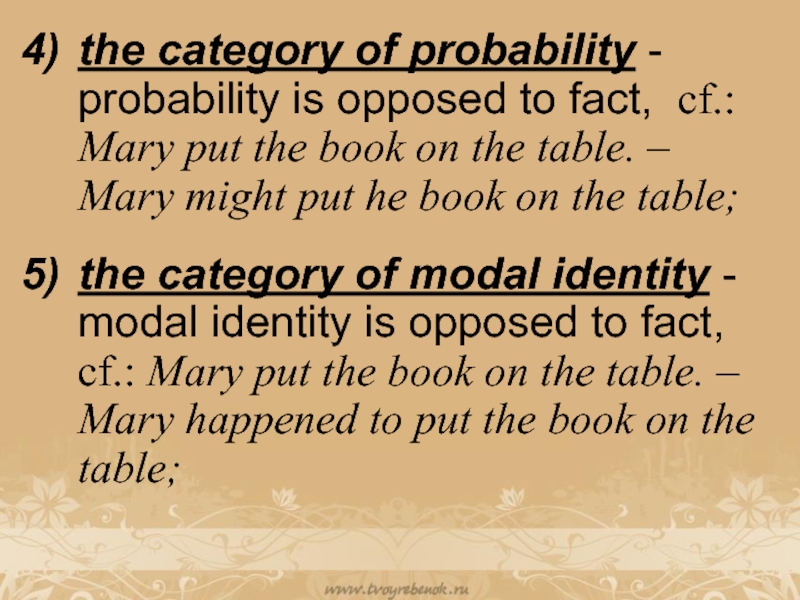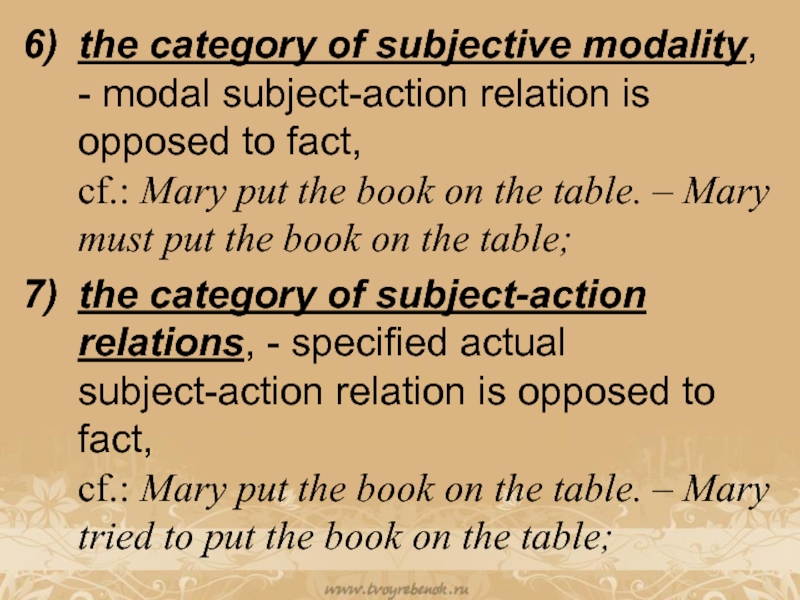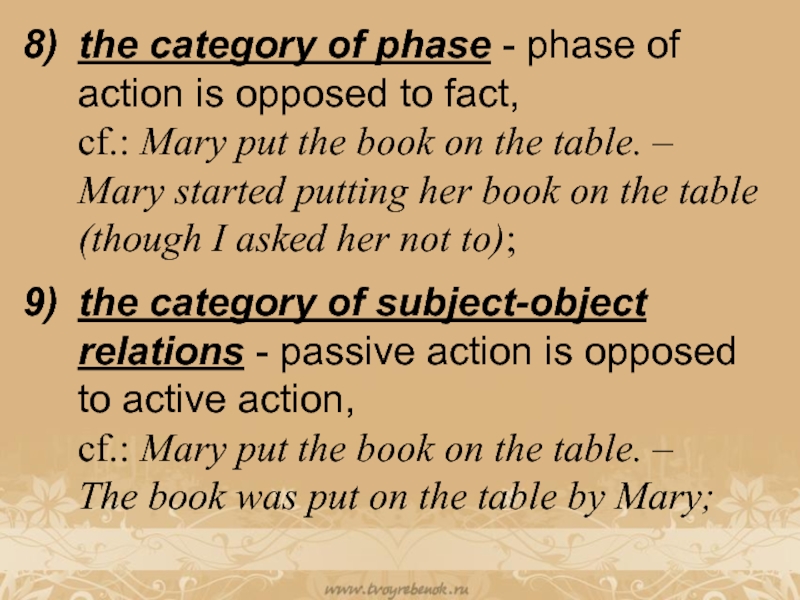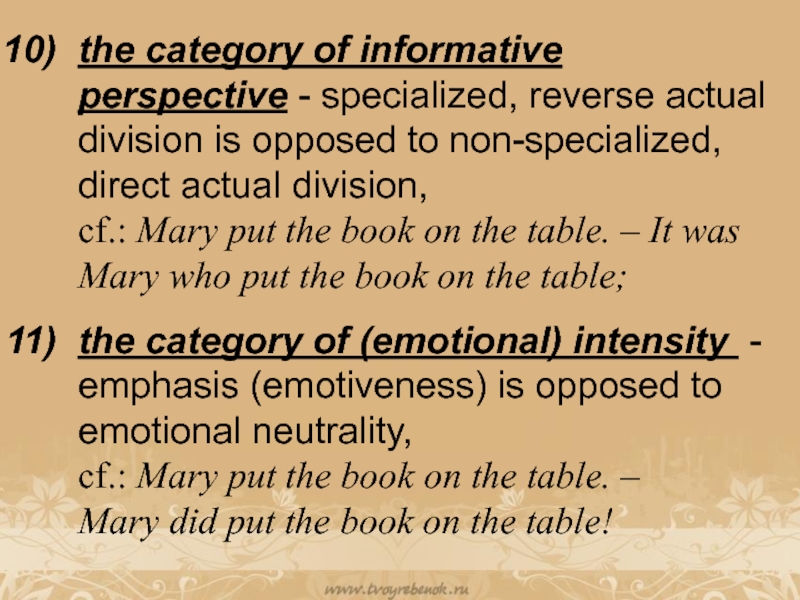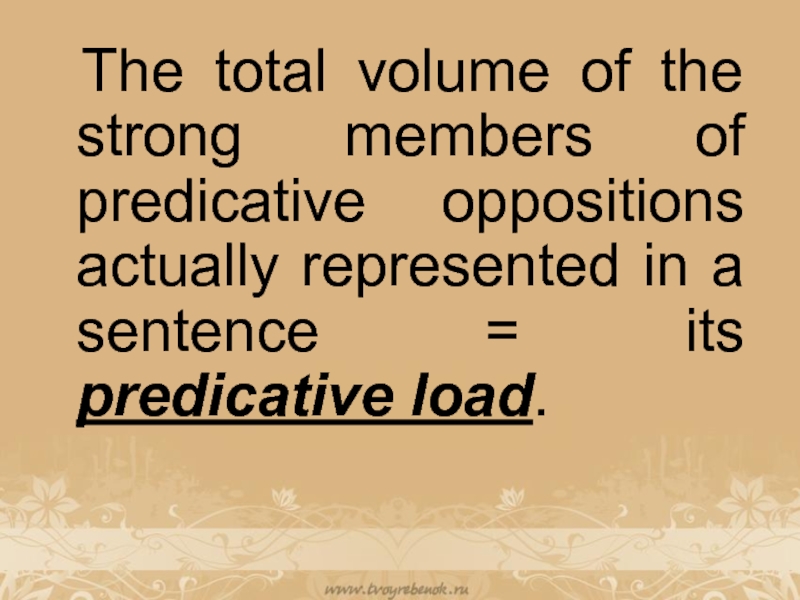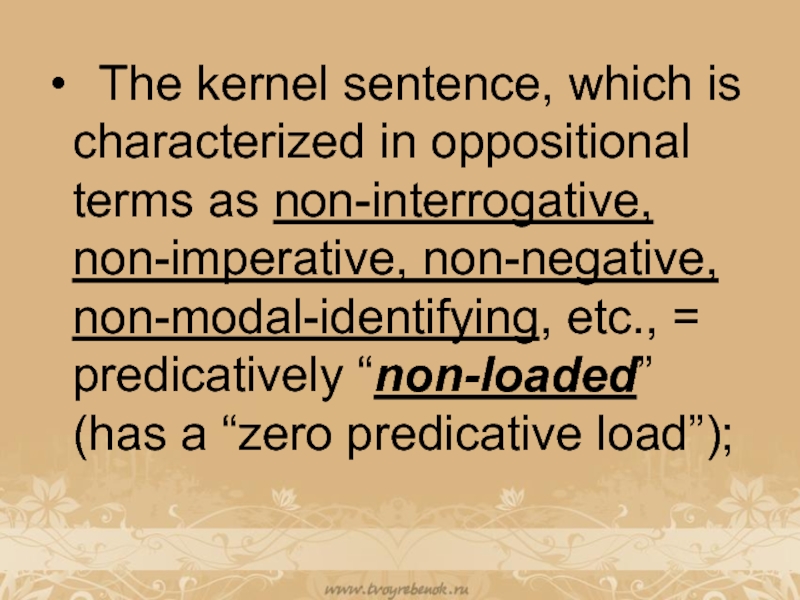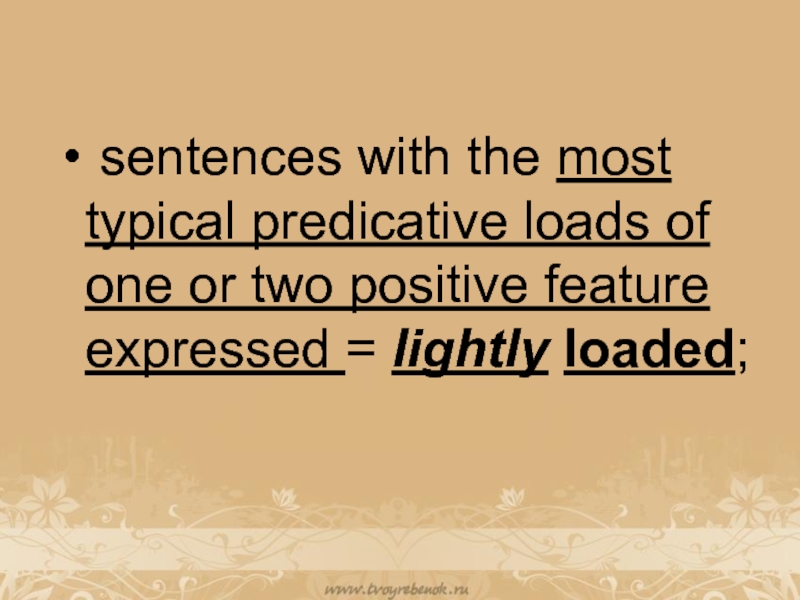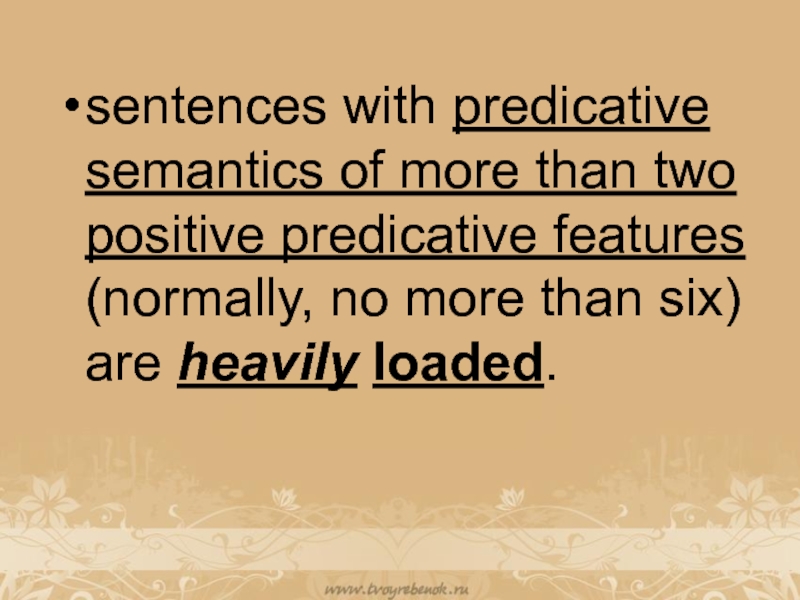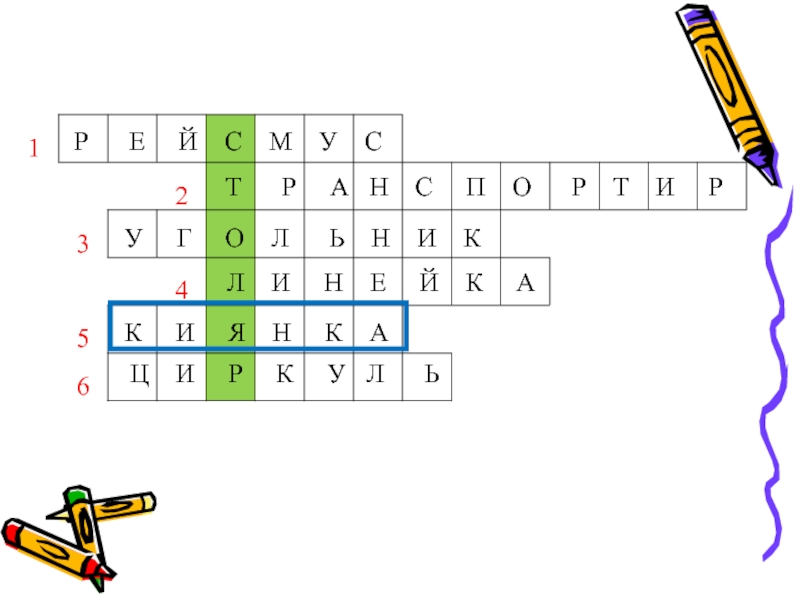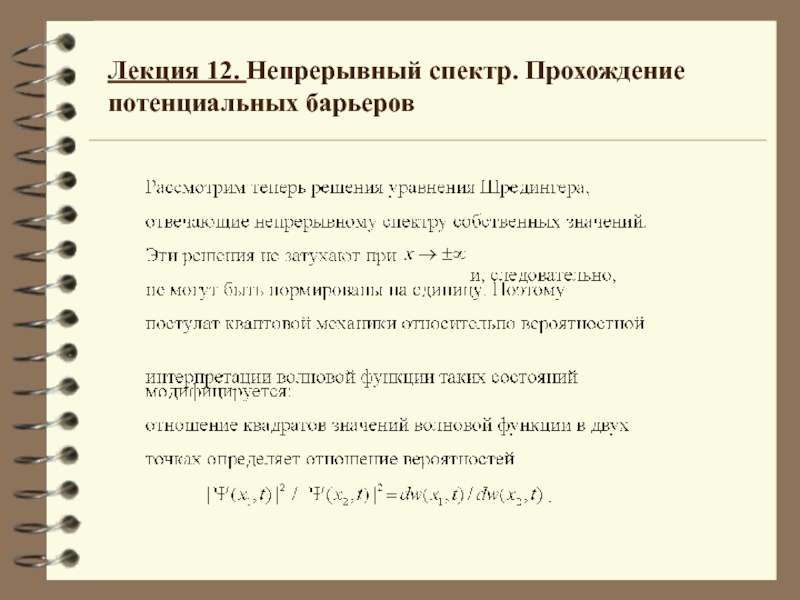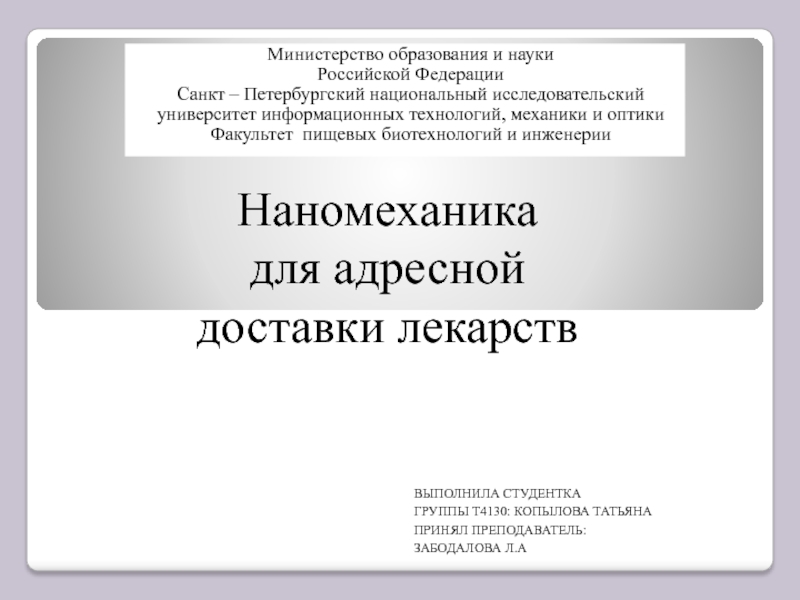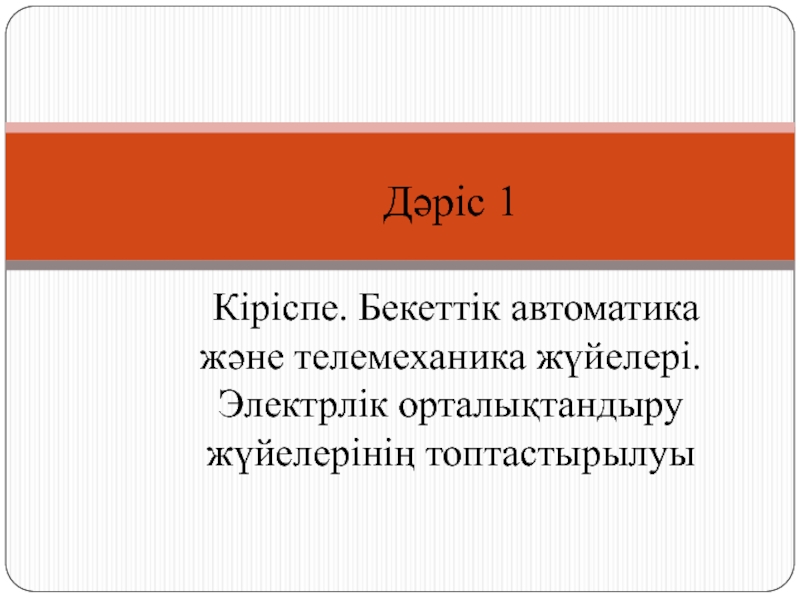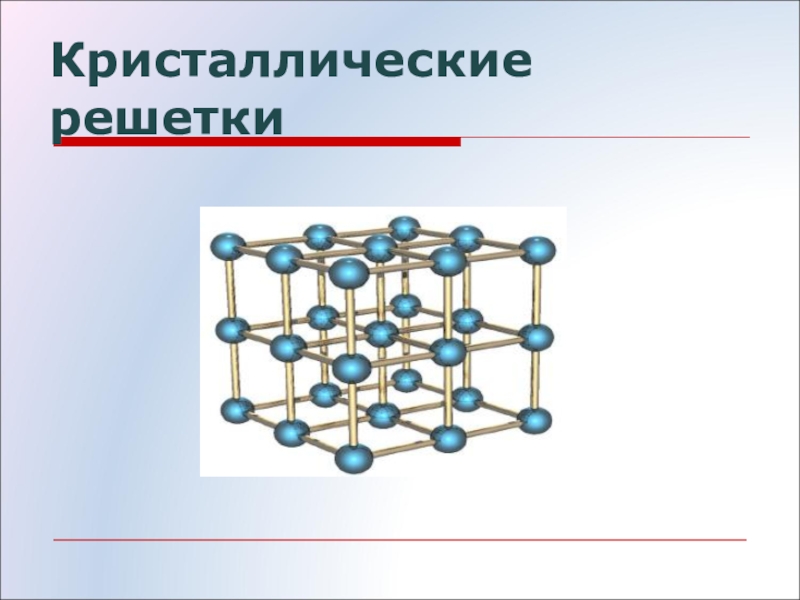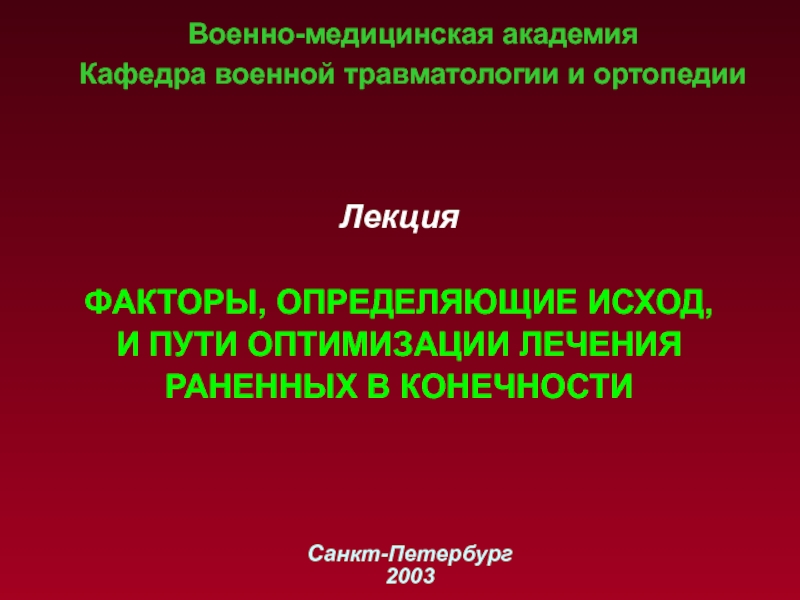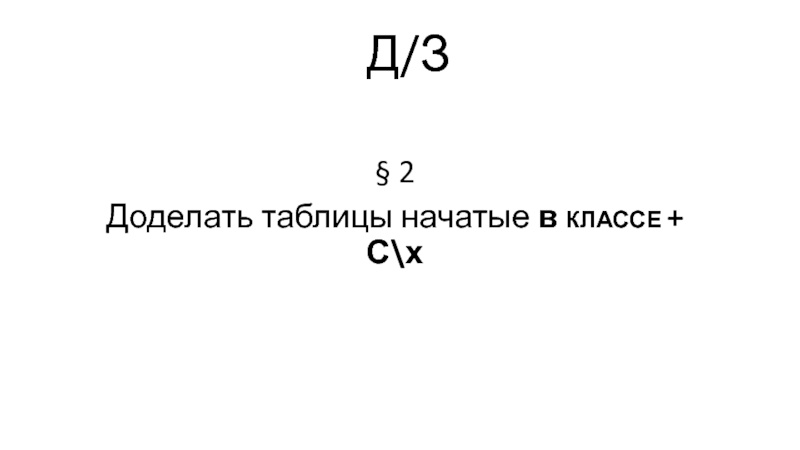Разделы презентаций
- Разное
- Английский язык
- Астрономия
- Алгебра
- Биология
- География
- Геометрия
- Детские презентации
- Информатика
- История
- Литература
- Математика
- Медицина
- Менеджмент
- Музыка
- МХК
- Немецкий язык
- ОБЖ
- Обществознание
- Окружающий мир
- Педагогика
- Русский язык
- Технология
- Физика
- Философия
- Химия
- Шаблоны, картинки для презентаций
- Экология
- Экономика
- Юриспруденция
Lecture 21 SIMPLE SENTENCE
Содержание
- 1. Lecture 21 SIMPLE SENTENCE
- 2. PLAN1. Constituent structure notional parts of the sentence expanded and unexpanded sentences
- 3. complete and incomplete (elliptical) sentences semantic classification of simple sentences
- 4. 2. Paradigmatic structure derivational procedures clausalization and phrasalization predicative functions
- 5. Constituent structure.
- 6. the finite verb + the subject =
- 7. sentences are divided into: monopredicative - one
- 8. a) notional parts of the sentence
- 9. simple sentence = a system of
- 10. Hierarchy of members: 1) principal (main):the subject the predicate, modify each other
- 11. the subject is the “person” modifier of
- 12. 2) secondary:the object – a substance modifier
- 13. the adverbial modifier – a quality modifier
- 14. the address (addressing enclosure) – a modifier
- 15. nominative parts of the sentence
- 16. linear analisysMy child always obeys me.
- 17. IC analisysMy child always obeys me. Pron N D V Pron NP VP VP S
- 18. b) expanded and unexpanded sentences
- 19. may or may not be actually represented
- 20. the category of “elementary sentence” = a
- 21. Simple sentences can be:unexpanded
- 22. ‘He gave me the book’ unexpanded -
- 23. ‘He gave me a very interesting book’
- 24. c) complete and incomplete (elliptical) sentences
- 25. the axes of the sentence: the
- 26. Sentence with both axes present complete
- 27. free one-axis sent. – the zero axis
- 28. Examples of fixed one-axis sentences: emotionally colored
- 29. various emphatic constructions,
- 30. BUT!negation and affirmation formulas (Yes; No; All
- 31. + exclamations of interjectional type,
- 32. d) semantic classification of simple sentences
- 33. The semantic classification of simple sentences is based on principal parts semantics.
- 34. A. On the basis of subject categorial
- 35. 2) personal; a) human definite, e.g.: I
- 36. b) non-human. animate, e.g.: A cat entered
- 37. B. On the basis of predicate categorial
- 38. 2) substance featuring (“nominal”); a) factual, e.g.:
- 39. C. subdivisions of simple sentences based on
- 40. compound, compound nominal predicates with pure and specifying link verbs (She looked beautiful).
- 41. compound verbal predicates CV modal Pr (You
- 42. D. On the basis of subject-object relations,
- 43. 2. Paradigmatic structure.
- 44. Traditionally, the sentence was studied only
- 45. Regular paradigmatic description of syntax started in
- 46. various sentence patterns various functional meanings
- 47. Study of these oppositions distinguish formal
- 48. a) derivational procedures
- 49. syntactic derivation starts with the kernel sentence
- 50. Derivation of a sentence = several transformational steps
- 51. transformational steps morphological arrangement of the sentence
- 52. the use of functional words (functional
- 53. the process of substitution, (the use
- 54. 4) deletion, i.e. elimination of some elements
- 55. the process of positional arrangement, (changes
- 56. 6) the process of intonational arrangement, i.e.
- 57. These steps may be employed either alone
- 58. Types of derivational relations in the paradigmatic
- 59. b) clausalization and phrasalization
- 60. kernel sentencestransformsclausesphrases
- 61. clausalization = the transformation of a
- 62. use of conjunctive words; the change
- 63. Cf.: The team won. + It caused
- 64. phrasalization = the transformation of a base
- 65. types of phrasalization: nominalization, i.e. the transformation of a sentence into a nominal phrase;
- 66. ►complete nominalization
- 67. ► partial nominalization
- 68. c) predicative functions
- 69. a kernel sentence undergoes transformations connected with the expression of predicative syntactic semantics
- 70. Predicative functions, expressed by primary sentence patterns,
- 71. 2. higher, “evaluative”; they are expressed by
- 72. 1) the category of communicative purpose: the
- 73. the category of existence quality (affirmation and
- 74. the category of probability - probability is
- 75. the category of subjective modality, - modal
- 76. the category of phase - phase of
- 77. the category of informative perspective - specialized,
- 78. The total volume of the strong
- 79. The kernel sentence, which is characterized
- 80. sentences with the most typical predicative
- 81. sentences with predicative semantics of more than
- 82. Why on earth has Mary failed to
- 83. Скачать презентанцию
PLAN1. Constituent structure notional parts of the sentence expanded and unexpanded sentences
Слайды и текст этой презентации
Слайд 2PLAN
1. Constituent structure
notional parts of the sentence
expanded
and unexpanded sentences
Слайд 42. Paradigmatic structure
derivational procedures
clausalization and phrasalization
predicative functions
Слайд 6the finite verb + the subject = the basic predicative
meaning of the sentence
= predicative line of the sentence
Слайд 7sentences are divided into:
monopredicative - one predicative line, i.e.
simple,
polypredicative = two or more predicative lines, i.e. composite and
semi-composite.Слайд 9 simple sentence = a system of function-expressing positions reflecting
certain element of situation.
Each position = the member
of the sentence. They are arranged in a hierarchy each of them modifying the others.
Слайд 11the subject is the “person” modifier of the predicate,
the
predicate is the “process” modifier of the subject;
they are
interdependent.Слайд 122) secondary:
the object – a substance modifier of the predicate;
the attribute – a quality modifier of substantive parts, either
the subject or the object; the apposition – a special kind of an attribute, a substance modifier of the subject;
Слайд 13the adverbial modifier – a quality modifier of the predicate;
the parenthesis (parenthetical enclosure) - a detached speaker-bound modifier either
of one of the nominative parts of the sentence or of the sentence in general: To be sure, Morris had treaded her badly. He probably won’t be able to make it today. Слайд 14the address (addressing enclosure) – a modifier of the destination
of the whole sentence;
the interjection (interjectional enclosure) – an
emotional modifier.Слайд 15 nominative parts of the sentence are syntagmatically connected,
the relations between them can be representned in
a linear as well as in a hierarchical way Слайд 19may or may not be actually represented in the sentence.
This is determined by the valency of the verb-predicate
Sentence parts
obligatory
optional
Слайд 20the category of “elementary sentence”
= a sentence in
which all the positions are obligatory
(the principal parts +
complementive modifiers). Слайд 21 Simple sentences can be:
unexpanded = elementary sentence,
includes only obligatory nominative parts;
expanded - includes some optional parts,
i.e. supplementive modifiers, which do not change the simple sentence into a composite or semi-composite sentence. Слайд 22‘He gave me the book’
unexpanded - all the nominative
parts of this sentence are required by the obligatory valency
of the verb to give;cf.: *He gave…; He gave me… - semantically and structurally deficient.
Слайд 23‘He gave me a very interesting book’
expanded - includes
the attribute-supplement very interesting;
is reducible to the elementary unexpanded
sentenceСлайд 25 the axes of the sentence:
the subject group
(the subject axis)
the predicate group (the predicate axis).
the
subject and the predicatethe subordinate secondary parts
+
Слайд 26Sentence with both axes present complete sentences (“two-member sentences”
or “two-axis sentences”).
Sentence with one of the axes present
incomplete sentences, (“one-member sentence”, “one-axis sentence) e.g.: What a nice day!Слайд 27free one-axis sent. – the zero axis can be easily
restored from the conext. Elliptical sentences: e.g.: Who is there?
– Your brother.fixed one-axis sent. - the absent axis cannot be easily and accurately restored.
Слайд 28Examples of fixed one-axis sentences:
emotionally colored name-callings,
e.g.: Brute!;
psychologically tense descriptions,
e.g.: Night. Silence. No one in sight (so-called nominative sentences); Слайд 29various emphatic constructions,
e.g.: To ask a question
like this! What a joy!;some conversational formulas, e.g.: Thank you! Nice meeting you!; etc.
Слайд 30BUT!
negation and affirmation formulas (Yes; No; All right),
vocative sentences
(Ladies and gentlemen! Dear friends!),
greeting and parting formulas (Hello!
Good-bye!) belong to the periphery of the category of the sentence
Слайд 31 + exclamations of interjectional type, like My God!
For heaven’s sake! Gosh!, etc.,
= “pseudo-sentences”, or
“non-communicative utterances” render no situational nomination, predication or informative perspective of any kind
Слайд 34A. On the basis of subject categorial meaning, sentences are
divided into
1) impersonal, e.g.: It drizzles; There is no use
crying over spilt milk; a) factual, e.g.: It drizzles;
b) perceptional, e.g. It looks like rain. It smells of hay here.
Слайд 352) personal;
a) human
definite, e.g.: I know it;
indefinite, e.g.:
One never knows such things for sure.
Слайд 36b) non-human.
animate, e.g.: A cat entered the room;
inanimate,
e.g.: The wind opened the door.
Слайд 37B. On the basis of predicate categorial meaning, sentences are
divided into
1) process featuring (“verbal”)
a) actional, e.g.: I play
ball; b) statal, e.g.: I enjoy your party;
Слайд 382) substance featuring (“nominal”);
a) factual, e.g.: She is clever;
b) perceptional, e.g.: She seems to be clever.
Слайд 39C. subdivisions of simple sentences based on the structure of
the predicate:
predicates:
simple (I read)
compound,
Слайд 40 compound,
compound nominal predicates with pure and specifying link
verbs (She looked beautiful).
Слайд 41compound verbal predicates
CV modal Pr (You can prove it)
CV
aspect Pr (She started crying)
Mixed types
Слайд 42D. On the basis of subject-object relations, simple sentences are
divided into
subjective, e.g.: He is a writer;
objective, e.g.:
He is writing a book; neutral or potentially objective, e.g.: He is writing.
Слайд 44 Traditionally, the sentence was studied only syntagmatically.
F. de
Saussure: paradigmatics is quite natural for morphology, while syntax should
be studied primarily as the linear connections of words.Слайд 45Regular paradigmatic description of syntax started in the middle of
the 20th century
(N.Chomsky’s transformational grammar theory).
Слайд 46various sentence patterns
various functional meanings
They make up
syntactic categories = the oppositions of paradigmatically correlated sentence patterns.
Слайд 47Study of these oppositions distinguish formal marks and individual
grammatical meanings of paradigmatically opposed sentence patterns.
Слайд 49syntactic derivation starts with
the kernel sentence
= the elementary
sentence (the principal parts + complementive modifiers)
e.g.: Mary put
the book on the table. Слайд 51transformational steps
morphological arrangement of the sentence parts (word
forms within categories)
- changes of the finite form of
the verbe.g.: Mary put the book on the table Mary would have put the book on the table.
Слайд 52 the use of functional words (functional expansion), which transform
syntactic constructions
e.g.: Mary put the book on the table.
Did Mary put the book on the table?He understood my question. He seemed to understand my question.
Слайд 53 the process of substitution, (the use of personal, demonstrative
and indefinite pronouns and of various substitutive half-notional words),
e.g.:
Mary put the book on the table. Mary put it on the table.I want another pen, please. I want another one, please.
Слайд 544) deletion, i.e. elimination of some elements in various contextual
conditions,
e.g.: Put the book on the table! On
the table! Слайд 55 the process of positional arrangement, (changes of the word
order)
e.g.: Mary put the book on the table.
On the table Mary put the book. We must go. Must we go?
Слайд 566) the process of intonational arrangement, i.e. application of various
functional tones and accents,
e.g.: Mary put the book on
the table. Mary put the book on the table?(!)Слайд 57These steps may be employed either alone or in combination
with each other;
e.g. Where did Mary put the book?
the kernel sentence Mary put the book on the table,
Слайд 58Types of derivational relations in the paradigmatic system of sentences:
constructional relations - the formation of more complex syntactic structures
out of simpler ones, predicative relations - expression of the predicative semantics of the sentence.
Слайд 61 clausalization = the transformation of a base sentence into
a clause in the process of the subordinative or coordinative
combination of sentences.Слайд 62 use of conjunctive words;
the change of the word
order;
the change of intonational arrangement, deletion, substitution and other
derivational procedures may be involved. Слайд 63Cf.: The team won.
+ It caused a sensation.
The
team won and it caused a sensation; When the team
won, it caused a sensation.Слайд 64phrasalization = the transformation of a base sentence into a
phrase in the process of building the syntactic constructions of
various degrees of complexity.Слайд 65types of phrasalization:
nominalization, i.e. the transformation of a sentence
into a nominal phrase;
Слайд 66►complete nominalization the kernel sentence
a regular noun phrase
NO predicative semantics,
e.g.: The team won. the team’s victory; The weather changed. the change of the weather; Слайд 67► partial nominalization
the sentence a semi-predicative gerundial or infinitive
phrase part of its predicative semantics is lost,
e.g.: the team’s winning; for the team to win; the weather changing.
Слайд 69 a kernel sentence undergoes transformations connected with the expression
of predicative syntactic semantics
Слайд 70Predicative functions, expressed by primary sentence patterns, can be subdivided
into
1. lower - include the expression of such morphological
categories as tense and aspect; they have “factual”, “truth-stating” semantic character.Слайд 712. higher, “evaluative”; they are expressed by syntactic categorial oppositions,
they make up the following syntactic categories:
Слайд 721) the category of communicative purpose:
the first sub-category -
question is opposed to statement,
cf..: Mary put the book on the table. – Did Mary put the book on the table?;the second sub-category - statement is opposed to inducement, e.g.: Mary put the book on the table. – Mary, put the book on the table;
Слайд 73the category of existence quality (affirmation and negation) - affirmation
is opposed to negation, cf.: Mary put the book on
the table. – Mary didn’t put the book on the table;the category of realization - unreality is opposed to reality, cf.: Mary put the book on the table. – Mary would have put the book on the table…;
Слайд 74the category of probability - probability is opposed to fact,
cf.: Mary put the book on the table. – Mary
might put he book on the table;the category of modal identity - modal identity is opposed to fact, cf.: Mary put the book on the table. – Mary happened to put the book on the table;
Слайд 75the category of subjective modality, - modal subject-action relation is
opposed to fact,
cf.: Mary put the book on the table. – Mary must put the book on the table;the category of subject-action relations, - specified actual subject-action relation is opposed to fact, cf.: Mary put the book on the table. – Mary tried to put the book on the table;
Слайд 76the category of phase - phase of action is opposed
to fact,
cf.: Mary put the book on the table. – Mary started putting her book on the table (though I asked her not to);the category of subject-object relations - passive action is opposed to active action, cf.: Mary put the book on the table. – The book was put on the table by Mary;
Слайд 77the category of informative perspective - specialized, reverse actual division
is opposed to non-specialized, direct actual division,
cf.: Mary put the book on the table. – It was Mary who put the book on the table;the category of (emotional) intensity - emphasis (emotiveness) is opposed to emotional neutrality, cf.: Mary put the book on the table. – Mary did put the book on the table!
Слайд 78 The total volume of the strong members of predicative
oppositions actually represented in a sentence = its predicative load.
Слайд 79 The kernel sentence, which is characterized in oppositional terms
as non-interrogative, non-imperative, non-negative, non-modal-identifying, etc., = predicatively “non-loaded” (has
a “zero predicative load”);Слайд 80 sentences with the most typical predicative loads of one
or two positive feature expressed = lightly loaded;
Слайд 81sentences with predicative semantics of more than two positive predicative
features (normally, no more than six) are heavily loaded.
Слайд 82Why on earth has Mary failed to put my book
back on the table?!
expressing positive predicative semantics of
interrogations, subject-action relations and intensity; its predicative load is heavy.

